18th November, 2013
From Raymond Goh:
Today, the tomb keepers helped to clear the thick vegetation around a cluster of old graves in Hill/Blk 2, believed to be relocated from Tiong Bahru in the late 1920s due to development, thereby revealing more tombs previously hidden among thick vegetation. Some of these old graves are affected, while some are not due to the angle of the road project which slices this cluster into half. One pioneering immigrant, that of the mother of Chee Yam Chuan has been found in this cluster. We believe other pioneers could be uncovered soon.
Read about how Raymond identified Madam Chee Kim Guan here
Seeing the cleared tombs for the first time inspired Claire Leow to pen these lines for these pioneers, who arrived about the time of Sir Stamford Raffles, making them the earliest immigrants of recent history.
The Sentinels of Bukit Brown
We stand
Sentinels of Bukit Brown
Watched this land we called Sin-chew (星 洲) from afar
Put down roots, rebuilt our lives,
Cajoled our families to join us.
We, the sinkehs, arrived.
Farewells aplenty in our lifetimes
To family, to China.
Here in our new home, to our former burial grounds which looked after us,
As we made way for our descendants, and for more sinkehs.
Goodbye Tiong Bahru, hello Bukit Brown.
Years have passed. Like a gentle breath. Like the wind.
Bombs came, new inventions we did not yet know.
Shouts of languages we did not fully understand.
In death, others whispered to us that which we did not witness
The Japanese came with shouts of Banzai! The British scrambling in the undergrowth to hide amongst us.
Then peace and quiet again.
Roots grew around us, sheltered us.
And we hosted the birds and monkeys and spied an occasional dog. Hid a few snakes in our time.
We enjoyed the distant voices of children at play.
We, the sentinels of Bukit Brown.
And now,
Time for more farewells.
Our friends and neighbours in death,
Long have we stood together.
Decades have come and gone and among many farewells, we never expected the dead would be parted.
Not like this.
Ong, I see you over there. Chew, you look bright and clean with the grass trimmed. Lim, I never knew you had that many children!
So many years, and now, not enough time!
We don’t have time left to get to know each other better.
We thought we had eternity…
We thought we were the sentinels of Bukit Brown.
All we had was time.
Come, let us not tarry.
Lets get to know each other better.
Before our final farewell.
We who know how to depart and how to find new homes, come.
Footnote:
“Sin Chew” is a sobriquet for “Singapore” popularized by Nanyang literatus Khoo Seok Wan (also buried at Bukit Brown and to be exhumed for the highway). Singapore is an island surrounded by the sea, and with vessels and boats large and small anchored around it; the glitter of artificial lights at night are like a crown of illuminated stars (“星”) when viewed from afar. “洲” (zhou, island) and “舟” (zhou, boat) are homonyms: while the boat lights are like stars, those on the island are like the Big Dipper to accentuate the constellation. This is why the term “Sin Chew” is widely known by folks here and afar.
(Liang Shao Wen, “Nanyang Travels”, p. 62, circa 1920s, translated by Lai Chee Kien)
Related posts:
A Brief History: Walk of Fame, Darkly
Dateline Sunday 10 November, Kranji War Memorial.
Remembrance Day was commemorated at the Kranji War Memorial in a ceremony dedicated to those who died fighting for Singapore during World War II. Brownies Khoo Ee Hoon and Mok Ly Yng who attended the memorial service had another mission when they were there, to seek out the names of 5 soldiers who had been listed as missing in the Battle at Cemetery Hill (Seh Ong and Bukit Brown Cemeteries).
Based on war records, Ly Yng had already mapped out the dead and missing soldiers from the 4th Battalion, Suffolk Regiment, whose last known positions are right in the middle of the proposed 8-lane highway cutting across Seh Ong and Bukit Brown Cemeteries.
The 5 soldiers, named are not the only ones fallen in the battle.
“4x in yellow to the left of the green box represents 4 individuals known to be buried at that position. At the top of the bo along Lornie Road are know to be 5 soldiers (5x), as with the 1x (in green) at the Lornie Road houses. As these soldiers were located outside of the immediate threatened area, I did not include their names, so as to reduce map clutter.But I decided to keep them in the map to provide some context and indicate that there are in fact more soldiers around the area within the Greater BB area.” Mok Ly Yng.
At the Kranji War Memorial, the soldiers’ names on the memorial wall :
Corporal Davis Angus Adcock
Singapore Memorial Column 53, Kranji War Memorial
Missing: 12 Feb 1942
Lance Corporal Cecil George Meadows
Singapore Memorial Column 53, Kranji War Memorial
Killed: 14 Feb 1942
———-
Private Harry Thomas Cattermole
Singapore Memorial Column 54, Kranji War Memorial
Missing: 14 Feb 1942
Missing. Last seen on Hill 95, badly wounded on 14 Feb 1942.
Mok Ly Yng clarification of Cattermole’s position: “Due to the large map coordinate error, Cattermole could be buried within 50 m of the map coordinate’s position. in other words, he could be very, very to Oon Chim Neo’s grave too. In fact the uncertainty area overlaps her grave. “
Private Ivan Jonathan Warne
Singapore Memorial Column 56, Kranji War Memorial
Killed: 14 Feb 1942
Buried top of Highest hill Chinese Cemetery East of Adam Road in Adam Road – Lornie Road Area by padre Polain 2/26 Bn AIF 14.2.42 (crossed out May 1942) Effects 2 Identity Discs, 1 cross.
Private Ivan Jonathan Warne’s position is not affected by the road construction. He is listed as the only known unrecovered casualty to be buried in Bukit Brown Municipal Cemetery proper (Hill 1).
Mok Ly Yng on the case of Private P Sawyer in the map:
“The 5 named individuals on the map were known to have been killed or last seen at those map coordinates just before or after the surrender. But after the war, those who were recorded as’ buried’ could *not* be found again and their remains are still missing. Private P Sawyer is the most difficult to find. His records showed that he had ‘Died in Singapore’ on 14 Feb 1942 and that he was buried on 17 Feb 1942 but this burial record was crossed out at a later unknown date. This leaves him with no records and hence he does not appear on the Singapore Memorial at Kranji nor the Commonwealth War Graves Commission’s (CWGC) database or nominal roll, unlike the other 4 named soldiers presented here.”
In battle, the Cambridgeshire Regiment and the Suffolk Regiment fought in adjacent sectors. The Cambridgeshire Regiment held the Adam Park area while the Suffolk Regiment the Bukit Brown Cemetery area. In death, casualties of the two regiments are buried in adjacent sections at Kranji. This photo shows the boundary between the Cambridgeshire Regiment and the Suffolk Regiment in Kranji.
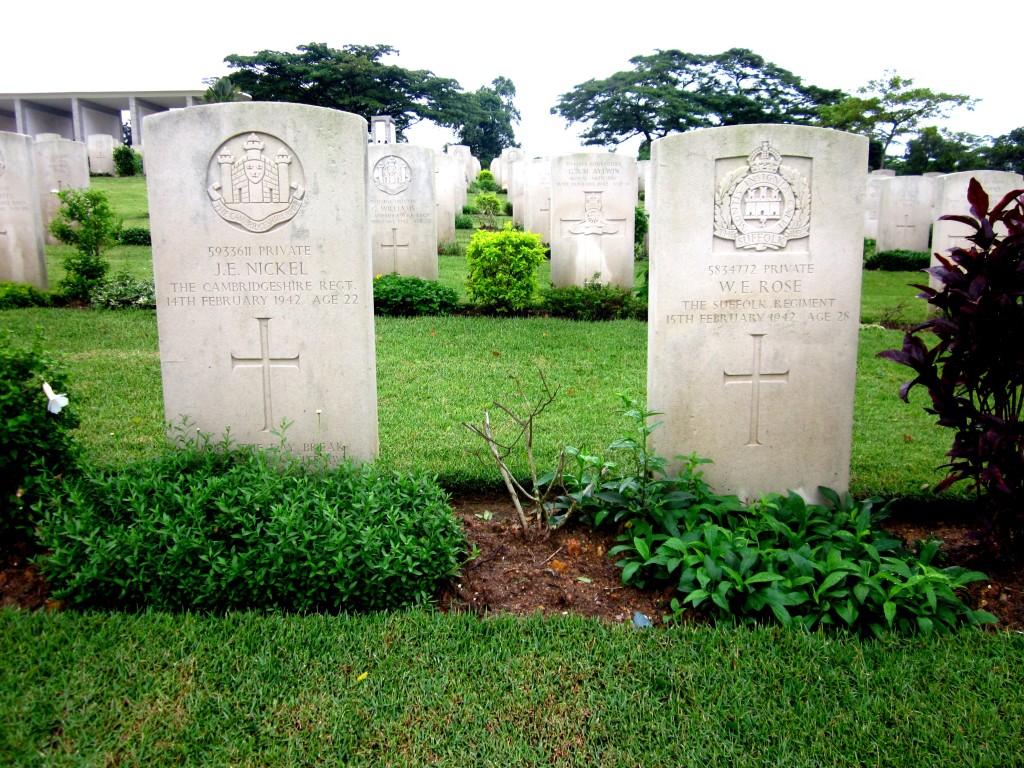
Kranji War Memorial Sunday 10 November, 2013. Cambridgeshire and Suffolk regiments (photo Mok My Yng)
From Jon Cooper. historian and war archeologist on the Adam Park Project, who also conducts the Battlefield Tour at Cemetery Hill once at month at Bukit Brown:
‘The fate of the missing Suffolks on Bukit Brown is just part of the rich WW2 heritage that can be found on the hills. There were many other units fighting in the area, constantly passing over the cemetery during the ebb and flow of warfare. It is most likely that there are more missing men to be found amongst the headstones.
There will also undoubtedly be spent ammunition and equipment to be found across the site, the remnants of fieldworks and bomb craters and the general detritus of war. Each item will be the part of a big jigsaw of artifacts and by plotting the locations in the landscape it will be possible to gather invaluable information about fighting that took place there.
The impending work on the hills will peel back the top layers and will undoubtedly expose these traces of the past.Hopefully the construction teams, with proper instruction will identify these clues and call in the experts to catalog and retrieve the material before the concrete is poured over it. There is a chance; just one chance to collect this invaluable evidence.
But most of all there is the possibility that we may come across the remains of our missing men. A chance to identify them and lay them to peaceful rest amongst their own. The fact that we go to great lengths to retrieve these men says as much perhaps about the attitude of Singaporeans today as it does about their generation of sacrifice.’
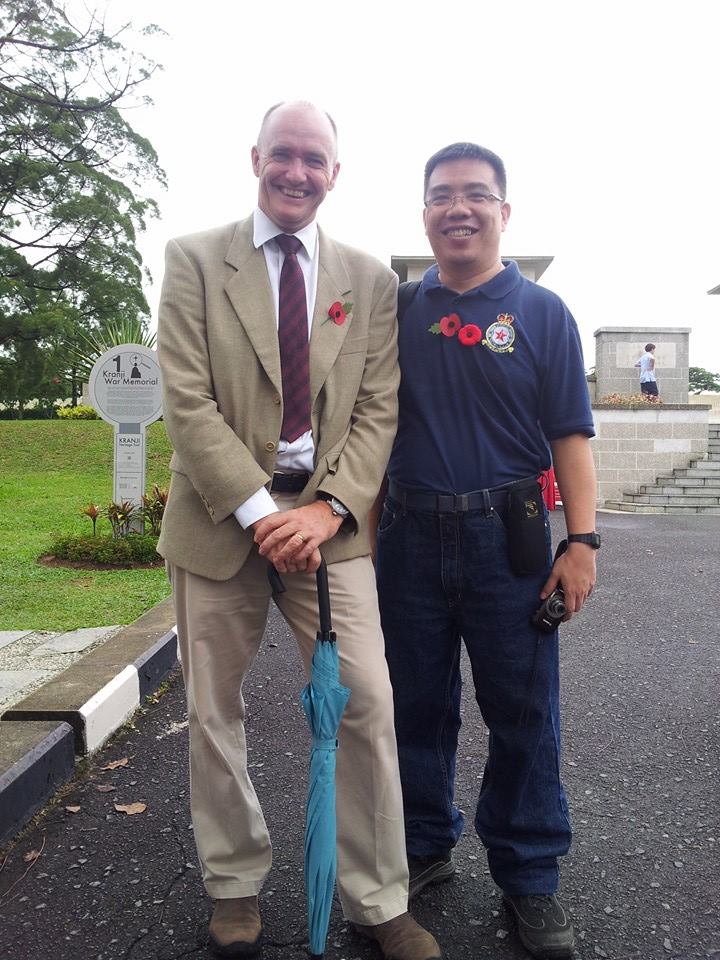
Jon Cooper and Mok Ly Yng who are working together to identify locations of the fallen Suffolk soldiers (photo Khoo Ee Hoon)

Mok Ly Yng at the memorial wall looking for the names of the fallen in the Battle on Cemetery Hill ( photo Khoo Ee Hoon)

The Suffolk Regiment casualties list on the Singapore Memorial at the Kranji War Memorial, columns 53 & 54. (photo Mok Ly Yng)
Mok Ly Yng is part of the documentation team tasked by the government to record and document graves affected by the impending highway
The Kranji War Memorial is dedicated to the men and women from United Kingdom, Australia, Canada, Sri Lanka, India, Malaya, the Netherlands and New Zealand who died defending Singapore and Malaya against the invading Japanese forces during World War II, it comprises the War Graves, the Memorial Walls, the State Cemetery, and the Military Graves.

Kranji War Memorial, Sunday 10 November 2013. A member of the Royal Air Force, which is Jon Cooper’s unit (photo Mok Ly Yng)
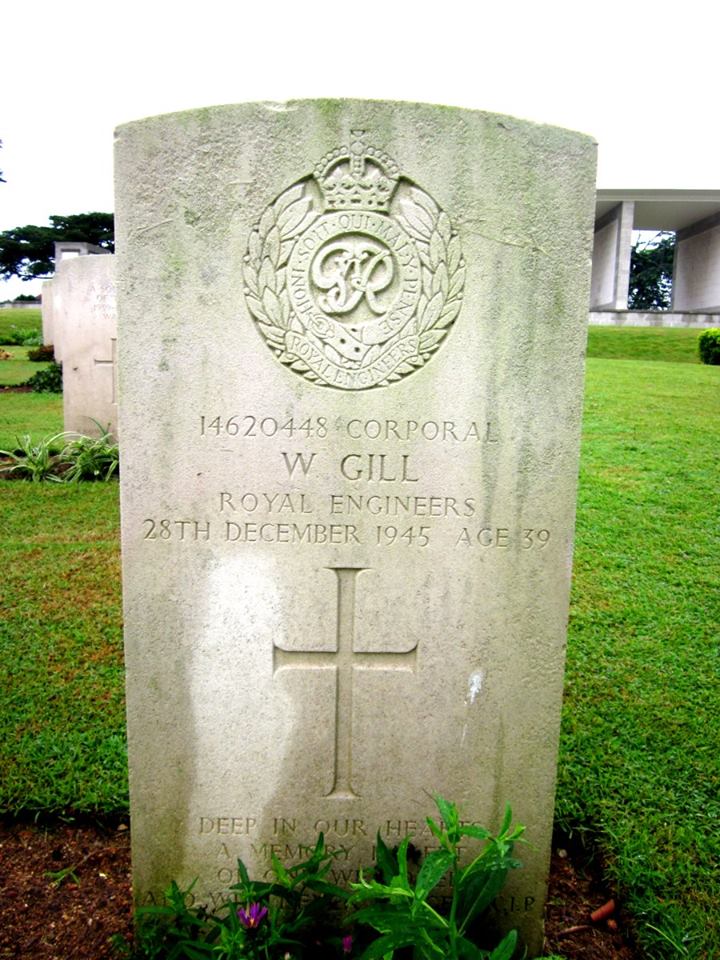
Kranji War Memorial, Sunday 10, November 2013. A member of the Royal Engineers, the unit responsible for mapping and map production (photo Mok Ly Yng)
Ubique Quo Fas Et Gloria Ducunt
Everywhere – Where Right and Glory Lead
The Case for a Bukit Brown (National) Heritage Park
by Chew Kheng Chuan
7 November, 2013.
Sometime ago when I was looking at Google Earth to check out Bukit Brown, I was struck by what a huge green lung it was that was contiguous to the main Water Catchment Area of MacRitchie and Pierce Reservoirs. In that sense the greenery was part of a single “critical mass,” whose significance – ecological and environmental – depended critically on its mass to create the climatic and rainfall needs of Singapore. I felt that taking away this greenery would be a major detraction and subtraction that cannot be replaced by the addition of many other smaller parcels that may add up to the same area if aggregated.
Otherwise I am very sympathetic to the pressures of the planners needing to look to the provision of housing and road requirements of a developing city and nation.
However I feel it is highly regrettable that Bukit Brown Cemetery has to be sacrificed on the altar of development. It will be an irretrievable loss. This is a resting place of the pioneers of our nation and is a cultural and historical heritage that is the physical expression of our sense of origins and identity.
Are there alternatives? This is a serious question that must be considered further and deeper. When Bukit Brown is developed into a future residential estate, the beneficiaries are limited to the fortunate people who will live there, next to the greenery of MacRitchie Reservoir. However it will be lost to the larger public.
Yet if Bukit Brown were to be gazetted as a National Heritage Cemetery Park, and developed as such, keeping all the graves which represent the earliest of burials in Singapore, and are an authentic expression of the anthropological rituals, ceremonies and culture of a people (still alive and active annually every Cheng Beng period), it can benefit all residents of Singapore, and into the future. Let me explain why.
Indeed the National Parks Board can look to developing this into a National Heritage Cemetery Park (or should that be the Bukit Brown Heritage Cemetery National Park?), develop the landscape and plantings, preserving the old trees, and grow new flora. Then it becomes a NEW environmental, recreational, cultural, historical, educational, natural, and yes, economical-tourism resource for all residents in Singapore – citizens, PRs, migrant workers, visitors, tourists, students, nature lovers, birdwatchers, filial descendents who observe the rites and rituals of Cheng Beng
It then becomes a public space rather than a private, historical, forgotten, “under-utilised” cemetery. Perhaps a stronger case can be made that this serves more powerfully the larger public good than the limited number of the lucky few future residents of the new residential estate of Bukit Brown?
An MRT has been planned and will be built for Bukit Brown – indeed, that will not detract from nor be wasted by the new identity and purpose of this National Heritage Park, for all of Singapore will need good transportation access to it to enjoy its benefits. The Bukit Brown MRT in a new status of Bukit Brown will in the longer run better justify its location and existence, bringing a far greater number of commuters to it than that planned for just residents of the area were it to be an exclusive residential district.
I would argue for considering such an alternative future for Bukit Brown to preserve its past of pioneer burials, and enhance its future, even if my ancestors were not buried there. Indeed, as a child I used to accompany my father and relatives every Cheng Beng, but with their passing I have discontinued this ritual for many decades, which explains why my children have never visited the grave of their great-great-grandfather Chew Boon Lay until recently
I asked my children what thoughts they might wish to share. They said:
“Our father told us we are 5th generation Singaporeans, which we think is cool. We wonder how many of our friends have been in Singapore for 5 generations? Our great great grandfather Chew Boon Lay and great grandfather Chew Hock Seng, are both buried at Bukit Brown. We’re kinda sad that when the cemetery is gone they will be just a memory and lost in our future.”
Chew Kheng Chuan is the great grandson of Chew Boon Lay.
Tripadvisor Travellers’ Choice® 2013 Winner “Ranked #16 of 665 attractions in Singapore. “
6 November, 2013.
Latest Reviews
“Get there before its too late…This is a very special place – peaceful, beautiful, historic, and a natural wildlife haven”
Visit Bukit Brown cemetery while you still can – before the bulldozers move in to create yet another expressway. This is a very special place – peaceful, beautiful, historic, and a natural wildlife haven. Intricately carved statues guard many of the old gravestones, which are often adorned with gorgeous antique tiles painted with flowers and peacocks. There are several pathways to explore and so the cemetery also makes a lovely place just to visit for a ‘country’ walk. Kingfishers, monitor lizards, monkeys and nightjars are common sights, and some of the huge banyan trees are staggering. In recent months the ‘Friends of Bukit Brown’ have painstakingly signed and cleared pathways to the gravestones of many notable names from Singapore’s history, making this an even more interesting place to visit.
Visited October 2013
HilarySingapore
Singapore is a concrete jungle and if there is a garden, it is man-made, like Gardens by the Bay…..(except for) a historical site called Bukit Brown.
Today, I had the privilege of touring a historical site called Bukit Brown. Bukit Brown is a cemetery, where many of Singapore’s pioneer are buried and may soon be “awakened” from their peaceful slumber to make way for 8 lanes highway.
I toured with volunteers of Bukit Brown, and learn about the tombs of Tan Kheam Hock and his family. History is being collected as I write this review. The tour is made even more interesting with the descendants of Tan Kheam Hock in our midst. A definitely worthy visit for any tourist to Singapore, to see a side of Singapore which money cannot buy.
As Bukit Brown tour is manned by volunteers with a passion to preserve the heritage and culture of this little city state, one will need to visit Bukit Brown FB page to make enquiries of any tours.
Visited October 2013
IreneLim63
It was like stepping back into another place and time. You can see rays of sunshine illuminating the misty verdant hills, rich smell of the forest and hear sounds of delightful birds. It was somewhat surreal in heavily urbanised city but the oasis of tranquility calms the soul and the mind is clarified. What a wonderful place to go for a walk!
I joined a friend to witness the Cheng Beng festivity and was overwhelmed by the throngs of people with their prayer paraphernalia and the heavy traffic winds patiently through the hills. It was BUSY!
Then some 3 months later, I took a trip with the Brownies who gave free guided walks through Bukit Brown practically every weekends! It was like stepping back into another place and time. You can see rays of sunshine illuminating the misty verdant hills, rich smell of the forest and hear sounds of delightful birds. It was somewhat surreal in heavily urbanised city but the oasis of tranquility calms the soul and the mind is clarified. What a wonderful place to go for a walk!
Yes, we have the crowded Botanic Gardens, the monotonous MacRitchie & Pierce reservoirs, the hot Sungei Buloh Reserve and Chek Jawa Park is a little too far to reach but Bt Brown is way too cool! If you dare venture off the main track, you will encounter unusual structure, designs, engravings, statutes, reflecting the various cultures, beliefs & eras. You might encounter a monitor lizard, horse riders and almost always expats walking their dogs. Join the Sats & Suns groups of 10-20 people on the guided walks like the one I’ve taken, listening to the passionate guides who are bursting to share with you the stories of the hills.
Visited September 2013
Ally A
“The most beautiful place on earth”
Jo Prudence, descendant of George Henry Brown, after whom the cemetery is named.
A spectacular time-lapse aerial video of Bukit Brown
More beauty shots of Bukit Brown here
This is a blog post that will be updated as the destruction continues……
Thursday 28 November ( Pre Exhumation Rituals) : The Roundabout has become a road
A reminder of what it once was, almost exactly a year back in December 2012 :
Friday 22 November
Wednesday 13 November , roundabout paved
Saturday, 9 November. Morning 9am, no works within the grounds.
Guided walks proceeded from the ‘ole rain tree. Respite!
Thursday, 7th November. The road works in progress
Paving the roundabout, and putting up hoardings along Adam Road.
Photos on Flicker on 7th November, 6pm here
Wednesday 6th November, other areas barricaded by concrete blocks
Wednesday 6th November, 2013 clearing continues at the roundabout
Tuesday 5th November, 2013. The roundabout is destroyed.
Friday, 11 October, 2013. The roundabout is barricaded and sealed
Before Oct 11, 2013. The Roundabout
Today, Tuesday 5th November, 2013, the roundabout at Bukit Brown was destroyed.
“Now a black bird wings across.
The low sky saw it open its beak. No sound comes.
What were we destroying?”
Too many pausing to question the dusk,
glorious colours drain within their eyes,
forgetting questions it stirred.”
— Chew Kheng Chuan, 1977
“A sense of history is what provides the links to hold together a people who came from the four corners of the earth. Because our history is short and because what is worth preserving from the past are not all that plentiful, we should try to save what is worthwhile from the past from the vandalism of the speculator and the developer, from a government and a bureaucracy which believes that anything that cannot be translated into cold cash is not worth investing in.”
S Rajaratnam, “The Uses and the Abuses of the Past”, Seminar on Adaptive Re-use: Integrating Traditional Areas into the Modern |
Urban Fabric, (Singapore, April 1984)
We made our share of mistakes in Singapore. For example in our rush to rebuild Singapore, we have knocked down many old and quaint Singapore buildings. Then we realized we were destroying a valuable part of our cultural heritage that we were demolishing what tourists found attractive and unique in Singapore. We halted the demolition. Instead, we undertook extensive conservation and restoration of ethnic districts such as Chinatown, Little India and Kampong Glam and of the civic district, with its colonial era buildings: the Empress Place, old British Secretariat, Parliament House, the Supreme Court, the City Hall, the Anglican Cathedral, and the Singapore Cricket Club.
The values of these areas in architectural, cultural and tourism terms cannot be quantified only in dollars and cents.
We were a little late, but fortunately we have retained enough of our history to remind ourselves and tourists of our past. We also set out to support these attractions by offering services of the highest standard.
Lee Kuan Yew, 13 March 1995
Han Yi Jie 寒衣节
By Victor Yue
4 November, 2013
Han Yi Jie, which means “warm clothing event”, is a Chinese tradition when the start of winter reminds the people that their ancestors and departed loved ones would also be experiencing the cold. And so, they make offerings of food and warm clothing for them.
In Singapore, where it is always warm (hot in fact), such a tradition hardly exists. But, Xuan Jiang Dian 玄江殿, a Chinese temple dedicated to Xuan Tian Shang Di (玄天上帝), known as God of the North, continues with this tradition. For a a long time now, every year without fail, on the first day of the tenth lunar month (moon), this temple, with its devotees would visit Bukit Brown Cemetery to make offerings to the wandering souls. To the Chinese, the first day of the 10th moon marks the beginning of Winter. (Wandering souls are souls of the departed who do not have anyone (descendants) making offerings to them)
This year the first day of the 10 lunar month, fell on 3 November. As has been their tradition, members of Xuan Jiang Dian 玄江殿 went to Bukit Brown Cemetery to make offerings to the wandering residents of the cemetery. This year saw a bigger offering. Could there have been an increase in the number of wandering souls? Devotees of the temple contributed warm clothings, money (in the form of joss papers) and food. Some Brownies also contributed towards the offering of the warm clothings (in the form of paper robes).
This year, Shan Cai Tong Zi 善才童子, through a spirit medium, came along to offer sermon (dharma) to the invited souls at the gathering by the Ole Rain Tree. Shan Cai Tong Zi is a deity who is one of the 500 assistants to Guan Yin.. In S.E,Asia, he is a popular deity who is trance by spirit mediums. He is only 3 years old and the older folks, especially old aunties, like him, because they can be less formal, unlike the warrior deities.
Shan Cai Tong Zi, through his ancient Hokkien and mudras offered blessings to the gathered souls. Offerings which ranged from various kinds of kueh kueh, joss sticks, coins to rice were made.
Offerings which ranged from various kinds of kueh kueh, joss sticks, coins to rice were made.
Before the start of this event, respects were also accorded to the guardians of the hills.
After the blessings and offerings to the wandering souls, it was time to bless the living souls who gathered to contribute towards this event. Good health and good luck were amongst them being blessed onto the members gathered. Members were offered the five different beans (known as Gor Tao 五豆 in Hokkien) to bring back home. A big “Huat Kueh” (a traditional Hokkien cake made with yeast and flour through steaming) that was made in the temple by members for this event was offered to all present to take bit to eat, for good luck and “jia peng an” (吃平安) meaning eating to get the peace”)。
With the impending construction of the 8 lane highway through Bukit Brown, this is likely the last time that Han Yi Jie will be conducted at the ‘ole rain tree. But we still hope it will not be the last at Bukit Brown.

Lighting the way by the barricades erected in preparation of the start of exhumation (photo Andrew Lim)
The Victorian Learning Journey at Bukit Brown
We did all we could in the name of education. As educators, our team believe we do have an obligation to do justice to our subject – History. Since Bukit Brown is a living classroom, it is thus a fecund ground for teaching and learning of History and across other subjects such as nature. We can’t let this opportunity slip away; rather late, but better than never.
We are truly proud of our student guides. They did an excellent job. They were so passionate and they fretted when the rain wouldn’t stop at 2 pm yesterday. The IP Year 2 guides, who are the younger ones (age 14), took the initiative to even share on the bus with their classmates while the rain was pelting on the roof and windows of the bus. When the rain stopped, they were so happy and eager to lead their peers out to meet Ong Sam Leong and all. Good kids. At the end of it all, I thanked them and encouraged them to volunteer as guides if their time permits. They seemed keen.
Caricatures of Fabian and Steven after a “training session” sketched by one of the boys.
by Walter Lim
(Published in Zaobao on 1 November, 2013, translated by Fabian Tee )
Taking a Closer Look at Singaporeans’ “Interest in the Wild (side)”
I refer to the commentary by Mr Goh Choon Kang ( a media professional and a former MP) entitled “Looking from the sidelines at Singaporeans’ interest in the wild side” dated Oct 23, 2o13. In it he posed the question : “why did the dialogue between civilian and government not take place before unilateral action was taken by one party with the expressed hope of opening more channels of communication? Just reflect for a moment, how the official in charge of heritage affairs must be feeling right now.”
This article has created considerable public misconception. The Prime Minister, after all, had on the occasion of the opening of the Heritage Festival 2013 said that:
“The government does not own the Singapore heritage. It does not define the Singapore heritage. Our heritage is a collection of individual memories, woven together into a national story. It is something that belongs to every Singaporean, and which each one of us can contribute to and help to preserve, individually and collectively”. PM Lee.
Therefore, it stands to reason that any civilian initiative to help Singapore preserve its heritage should be a source of comfort for the authorities. Besides, the National Heritage Board’s Alvin Tan is a broad-minded and enlightened official, and not a petty/small-minded individual as implied by Goh.
In Goh’s article entitled “The basis and limits of dialogue”, he stated that “perhaps I lacked culture or cultural depth, but I feel that most Singaporeans are unlikely to bring their old or young to a desolate place in the middle of nowhere during their free time”.
(I agree) Most people are of this (Goh’s ) same mindset – civilians and officials alike, think that way. It was under such dire circumstances that the application to World Monuments Fund was made. Can anyone imagine holding a dialogue under such circumstances? It would have been laughable. Fortunately the unrelenting efforts (of many) have paid off and many parents do bring their children and elderly parents to Bukit Brown. For his sake and society at large, I sincerely hope that Goh will deepen his cultural depth so that more young and old will come to Bukit Brown for leisurely walks.
On the government’s heavy burden of providing for the basic necessities for millions, Goh said that the volunteers are of the opinion that “you (government) can resolve to solve the existing traffic problems, just leave our Bukit Brown alone. For the record, many alternative plans/suggestions were submitted to the government once the road announcements were made. Subsequently there were suggestions to leave the tombstones by the roadside, blending the past with the modern. Recently, we also took part in the exercise to incorporate Biddari’s history into the planning of the new town. These efforts collectively demonstrate that the volunteers are trying to strike a balance between preserving the past and developing the future. Unfortunately, none of our suggestions/feedback for Bukit Brown found fertile ground and they have since fallen by the wayside.
On the other hand, the plan for Lornie Road reflects a lack of foresight and planning. Three years after expanding the number of lanes on Lornie/Adam Roads in 2009, the government now anticipates a reduction in the (Lornie) lanes after the Bukit Brown highway is built. Instead of expending money on the expansion and subsequent shrinking of Lornie Road, why not just build the Bukit Brown highway in the first place? The excitement that followed the government’s undertaking to quicken the pace of housing and transport infrastructural development after the last General Election quickly morphed into a hidden worry. Plans for building Bukit Brown highway were carried out without the benefit of any impact assessment particularly that of a heritage impact assessment in face of a large scale destruction of historic artifacts. In the final analysis, is the Bukit Brown highway really meant for development or is it an unmitigated disaster?
When the plans were announced last year, an estimated 5000 gravestones were to be affected and LTA then reduced that to 3746 due to a change in road plans. Now the official number has been re-estimated at 4153. What is really going on here? Even more worrisome for us is the sense of how heritage preservation is considered in this country. Minister Tan Chuan Jin said in parliament that (the preservation of) material culture including gravestone, carvings and tiles etc are very important. Yet after discussions at the higher level, there has been no concrete plans for a proposed memorial garden for the preservation of gravestones of important personalities. The imminent threat of destruction to thousands of graves has not provoke the local museums or Chinese clan associations to show any interest in preservation whatsoever. Dare I ask , is any government body or department truly satisfied with this (state of affairs) or process?
Leaving aside Goh’s portrayal of the Bukit Brown volunteers as a bunch of “wild enthusiasts”, this unlikely group of individuals who busy themselves over all things related to Bukit Brown, stands in stark contrast with the total lack of interest displayed by the leaders of the Chinese Clan Associations. This lackadaisical attitude even extends to the discovery of the tombstones of founding fathers of their clans.
At a time when the Gan Eng Seng alumni paid their respects to his grave during Qing Ming, the Chinese High and Nanyang Girls High and Industry Commerce Schools etc have instead chosen to forget their history.
When a country’s polity has no regard for our collective history and the hallowed grounds of our Chinese pioneers and civilisation, evoke nothing but disdain, are policies to blame and have the people all forgotten (the past)?
As Bukit Brown is doomed to its fate, a group of volunteers -whose ranks comprises Indian, Dutch and Japanese and others who know not a single Chinese character – are picking up the Chinese language to decipher tomb inscriptions, studying the various pioneers’ connections with old temples, clan associations, schools and some even extending their research into local history and the Chinese civilization. This abiding interest of the so called “wild enthusiast” calls for a deeper sense of reflection. Surely, this phenomenon is hardly one that can be understood by anyone looking from the sidelines.
More on the road expansion at Lornie Road here.
The full report in Chinese:
正视新加坡人的“野趣”
观点碰撞
吴俊刚先生在10月23日“侧观新加坡人的野趣”中说:“为什么
李总理在文化遗产节时说:“文化遗产并不专属政府,更不能由政府
吴先生曾在“协商的基础和限度”这篇文章就这么说:“也许我缺乏
武吉布朗就是在这种凄风苦雨的情况下,提出申请世界历史遗址,别
政府有为数百万公民解决衣食住行的重任,吴先生更说:“你可以设
反观罗尼路是未曾深思熟虑的工程,2009年扩建后通车三年,就
去年估计5000坟墓受影响,陆管局强调因修改道路设计而减少到
姑且不论武吉布朗学会为何成为吴先生笔下的“野趣”组织,倒是日
为政不思追慎远,一堆黄土惹人嫌,是政府的政策妨碍华社追慎远,
林志强
作者是文史工作者和武吉布朗华语导游
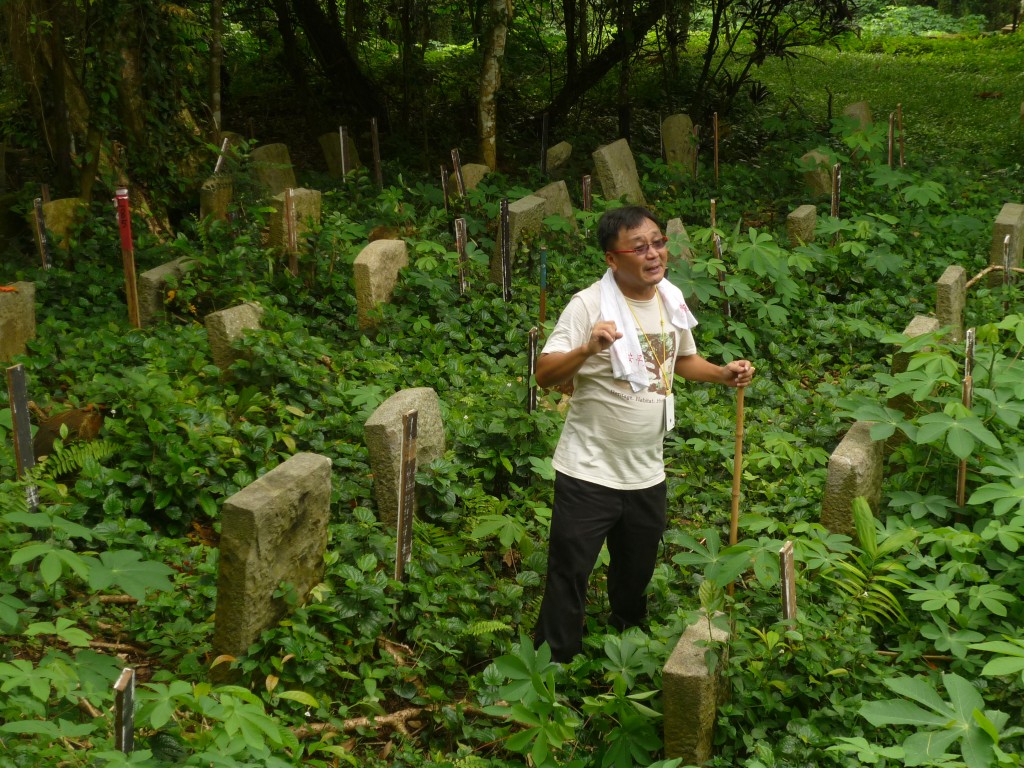
Cluster of Qing Tombs circa 1830s resited twice before Bukit Brown – now staked for exhumation to make way for 8 lane highway (photo Catherine Lim)
The Hindu Day of Remembrance
by Sugen Ramiah
1 November 2013
Like the Chinese who observe the annual “qing ming” or tomb sweeping festival in April, the Indians also honour their ancestors with a visit to their ancestors tombs on the Hindu day of remembrance. It takes place the Sunday before Deepavali, the festival of lights which falls on 2nd of November, Saturday.
On Sunday 27th November, I visited the Hindu cemetery located in Lim Chu Kang to pay respects and place offerings on my ancestors’ tombs.
My grandparents to date have a total of 125 descendants but sadly only 4 turned up, two cousins, my brother and myself.
The trip usually lasts for about two hours, as we’ll clean up five tombs, four in the Hindu Cluster and one in the Catholic cluster. Simple offerings including fruits and sweetmeats were placed on a banana leaf. With the lighting of an oil lamp and incense, the Indians remember their dearly departed.
In the evening at home, the entire family would gather. A feast that consists of eight dishes – chicken, mutton, eggs, fish, prawns, squid, crabs and vegetable, together with fruits, sweetmeats and Indian Peranakan delicacies such as the “kueh wajek”, will be laid before portraits of the ancestors. New cloths would be placed beneath the portrait, incense lit and finally the family members would eat the food that were offered.
Traditionally our forefathers from India were cremated , so there was never a need for tomb stones like the Chinese, Muslims and the Christians. The deceased were usually cremated within the day of death. But if they were wealthy, they would be given a burial. In the Hindu custom, the dead is also remembered on their death anniversary, known as a “theethi’”where a “mocham” lamp (light of liberation) is lit as a sign of remembrance.
Hindus have more than one festival to remember and honour their ancestors. On the full moon of the sixth lunar month of ‘Puratasi’ which falls in September/October, there is the ‘Mahalaya Amavasay’ also known as the fortnight of the ancestors. Hindus pay homage to their ancestors and offer prayers for the repose of their dearly departed at temples.
Some Hindus commemorate the dead during the Matu Pongal, on the second day of the “Pongol” Harvest Festival. The Indian Peranakans, known as the Chitty, celebrate the eve of Pongal with Bhogi Parachu – the ancestral worship festival. Since there were a few festivals to remember the dead, the local community here and in Malaysia decided that the Sunday before Deepavali will be the day of remembrance.
My grandfather, a wealthy merchant born in 1884, came to Singapore and contributed greatly to the Indian community of Singapore in the 1900s. He started the first dairy business here and contributed to the Sri Mariaman Temple in South Bridge Road He married my grandmother who was a Chitty- Indian Peranakan – from Melaka(Malacca) and she was the matriarch of the family. The honorary title is currently held by my aunt who is 85 this year.
As a Brownie, I have been moved by the descendants who return every year to Bukit Brown during “qing ming” to clean the tombs and pay their respects. I am also sadden by the tombs that lay neglected, which have been forgotten, and I hope more descendants will come forward and reconnect with their ancestors.
I am blessed and grateful to the friends/volunteers of Bukit Brown, who have kindly showed me how to appreciate and understand my own heritage and to be proud of who I am. This was the first time, my brother marked the remembrance day for our grandparents and it was for him an eye opening and moving experience.

Grandfather’s tombstone at the Hindu Cemetery, simple offerings of fruits, sweetmeats and roti prata were offered on top of a banana leaf (photo Sugen Ramiah)
Sugen Ramiah is a teacher by training and his interest includes observing and documenting Chinese festivals and rituals conducted by temples.
Read his blog posts on Salvation for Lost Souls here and here
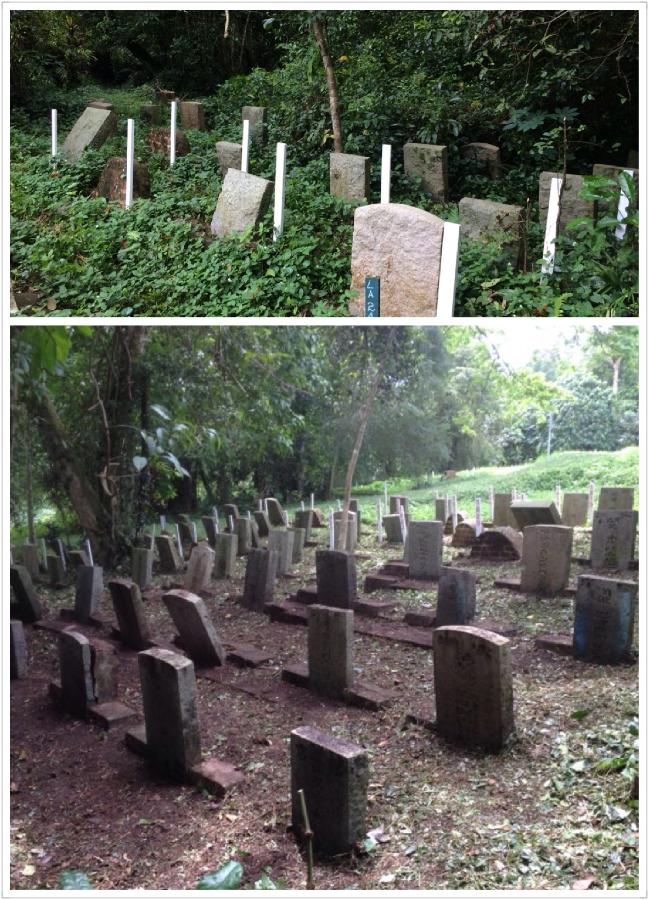


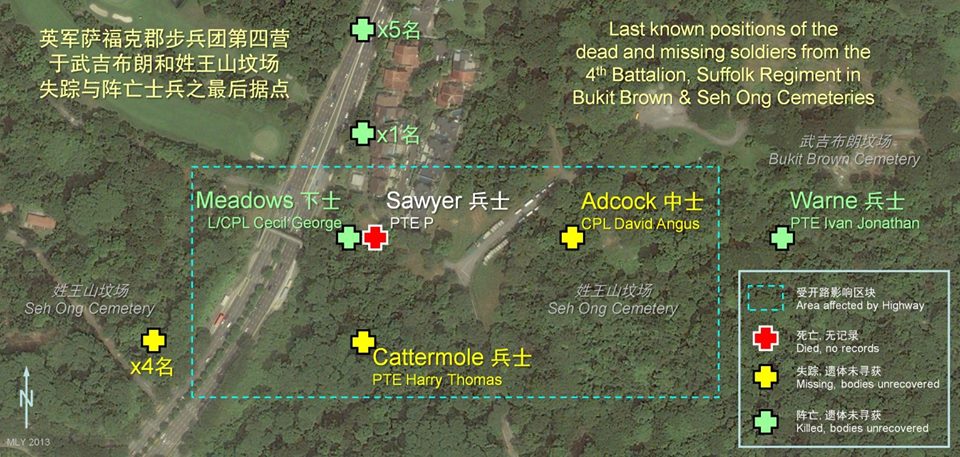
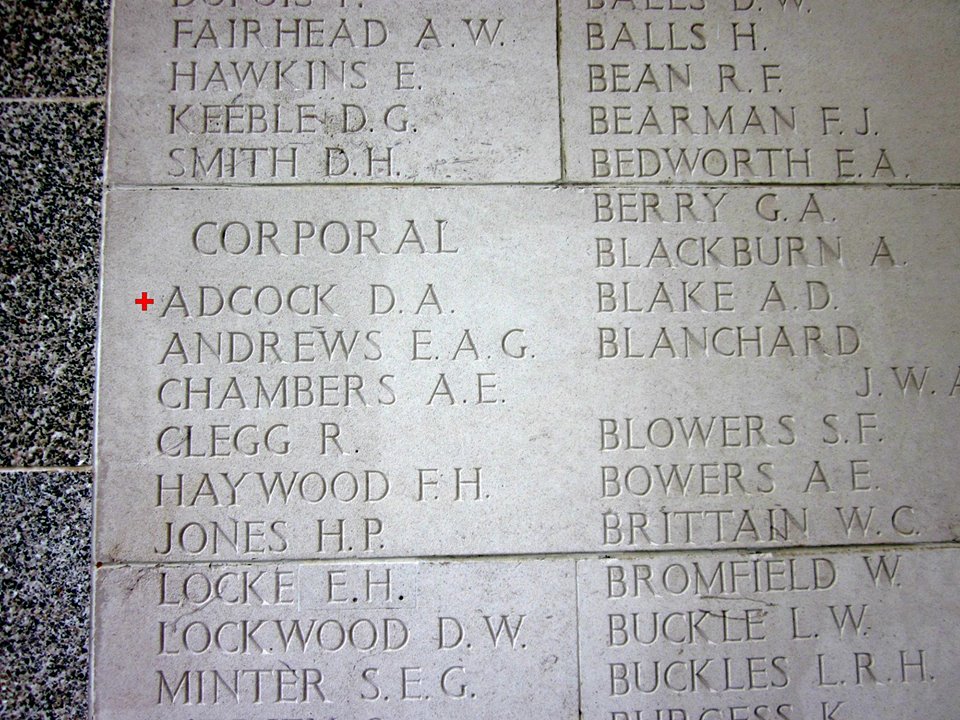
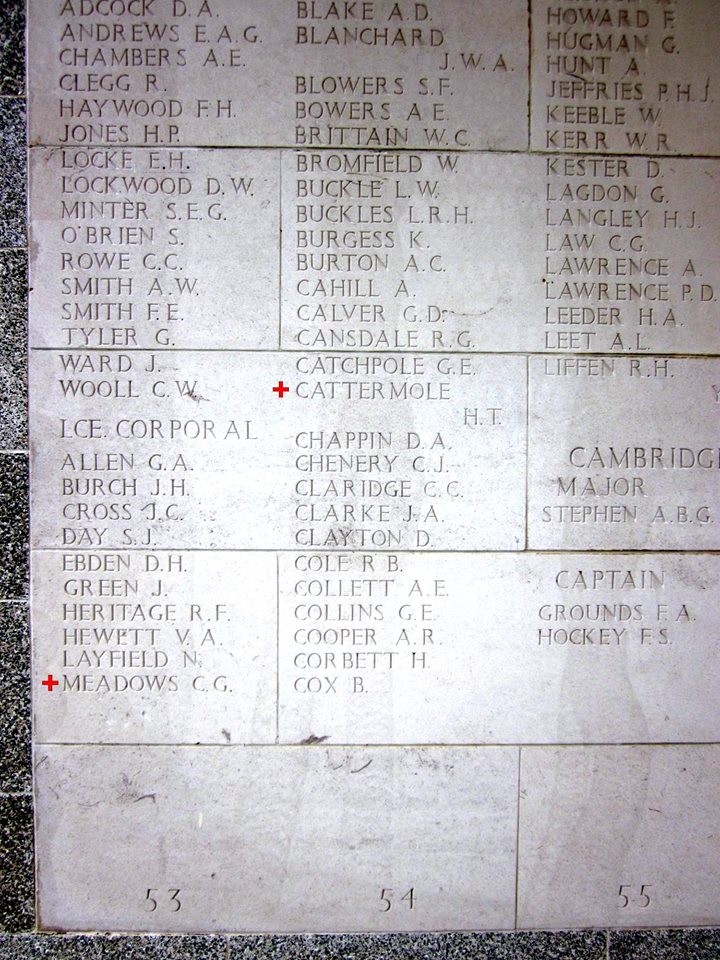
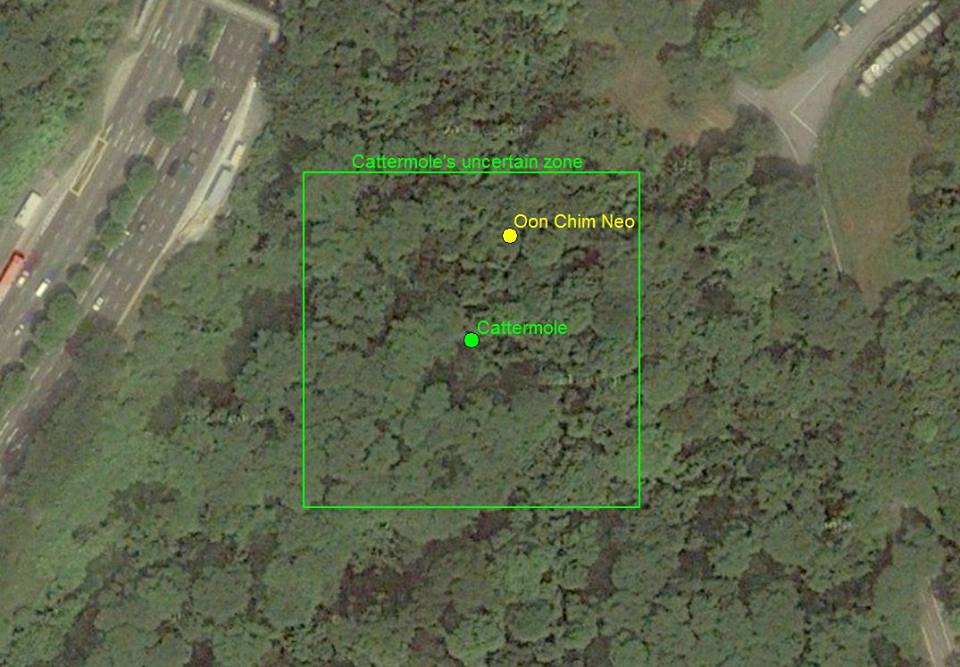
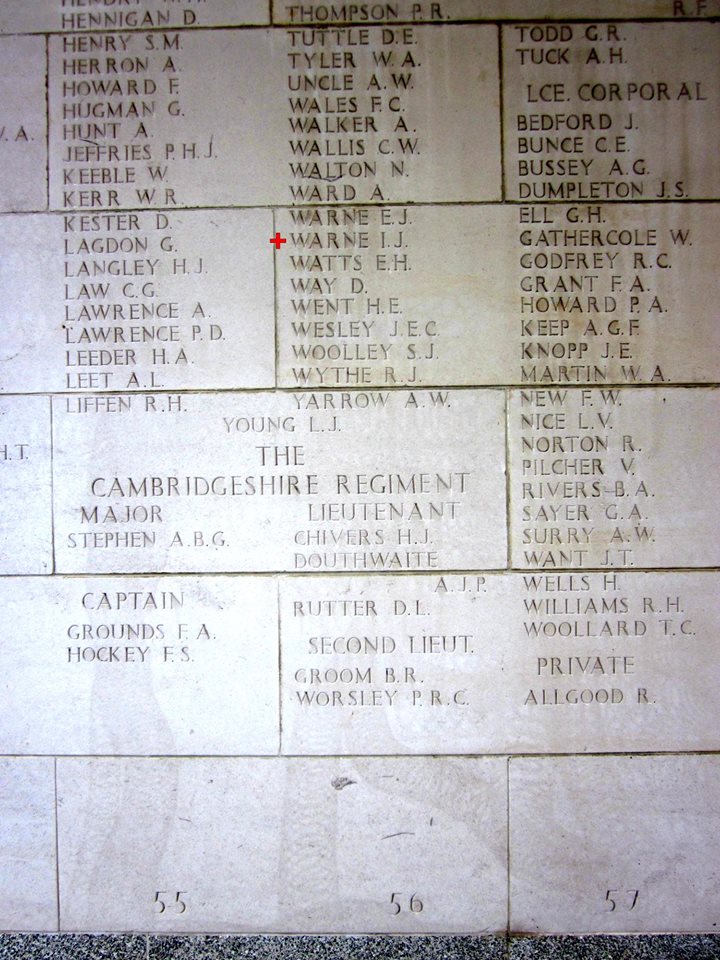
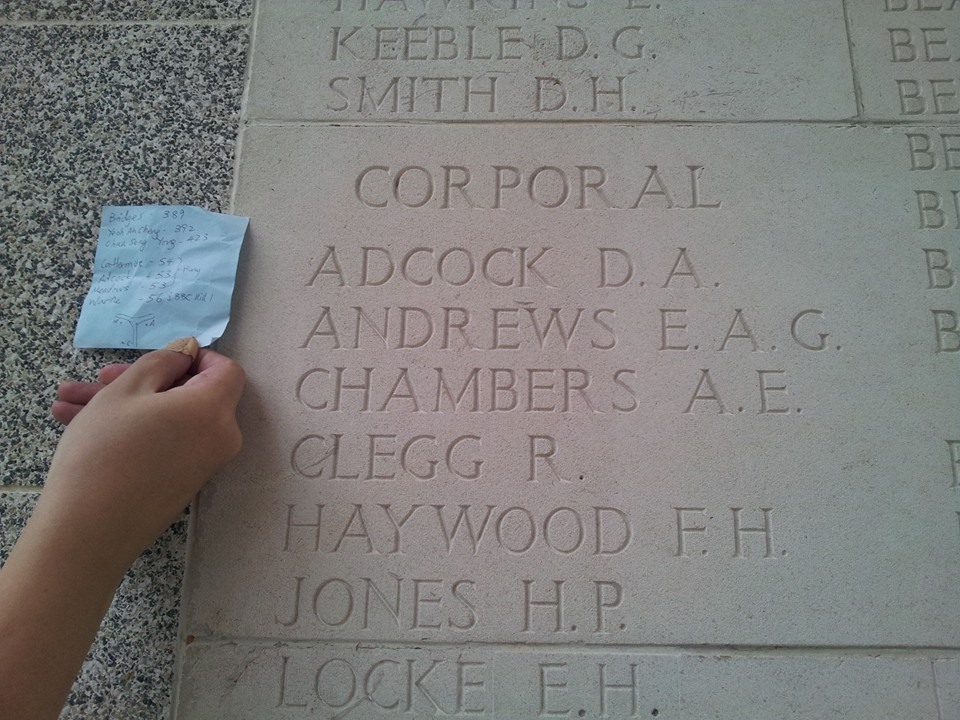

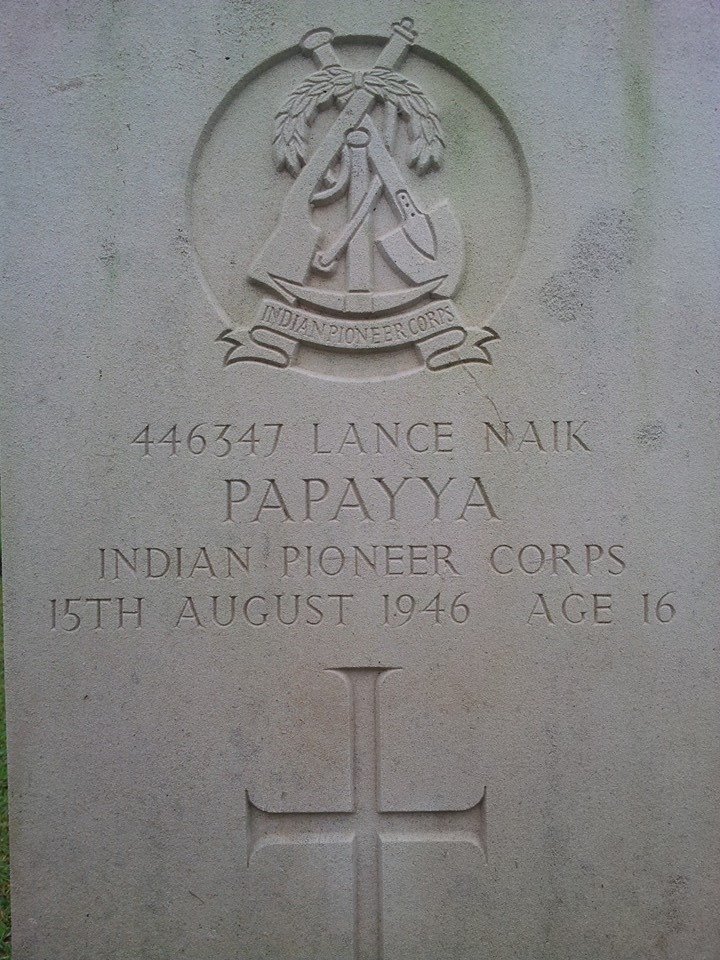
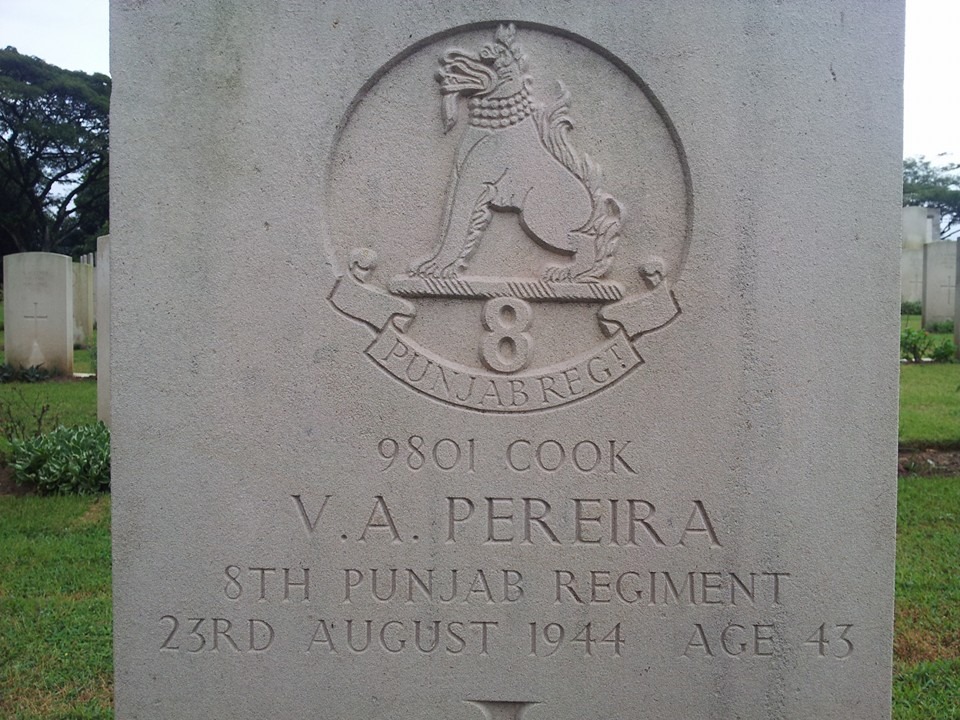
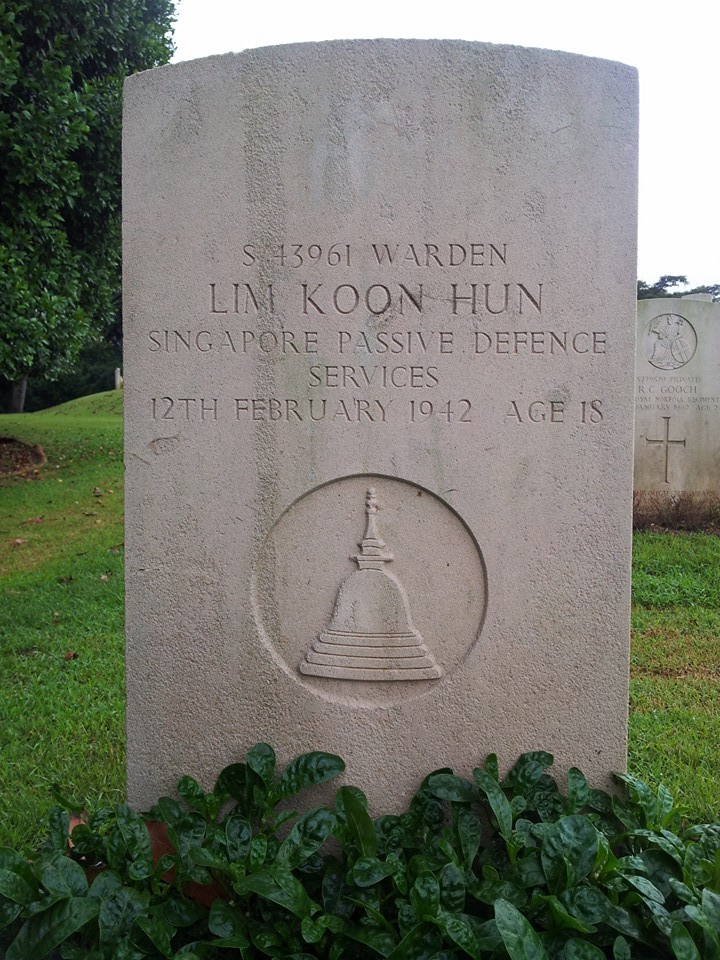



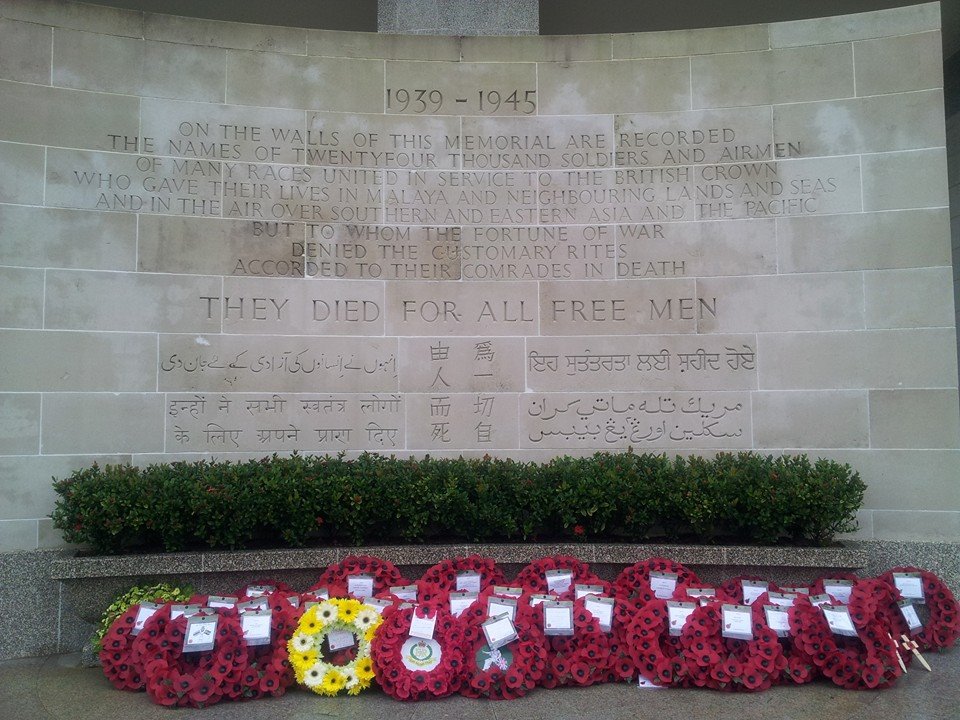
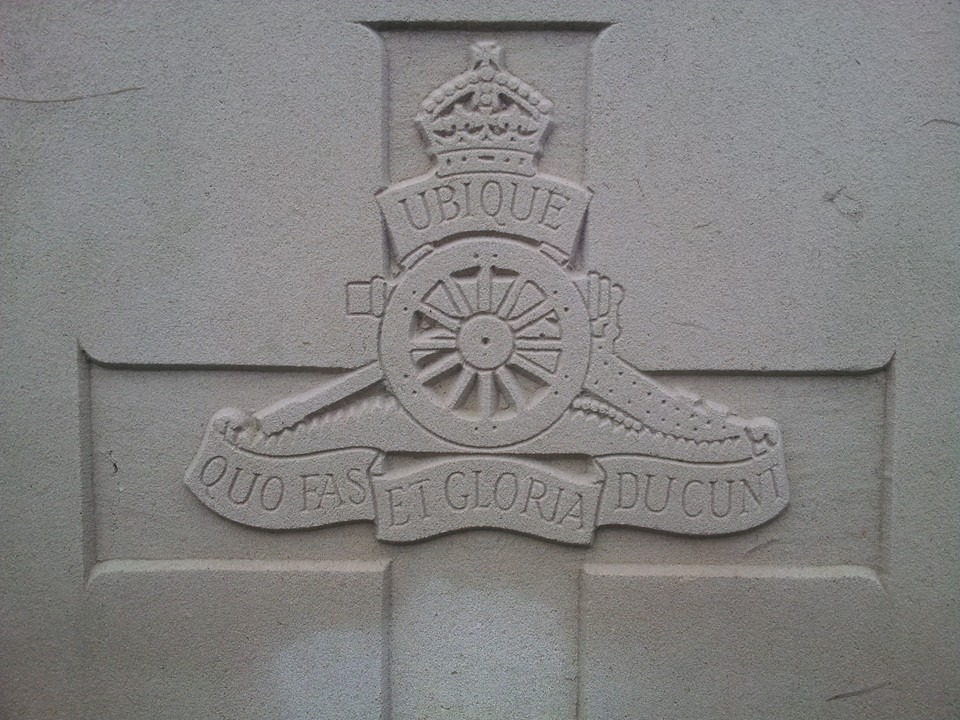
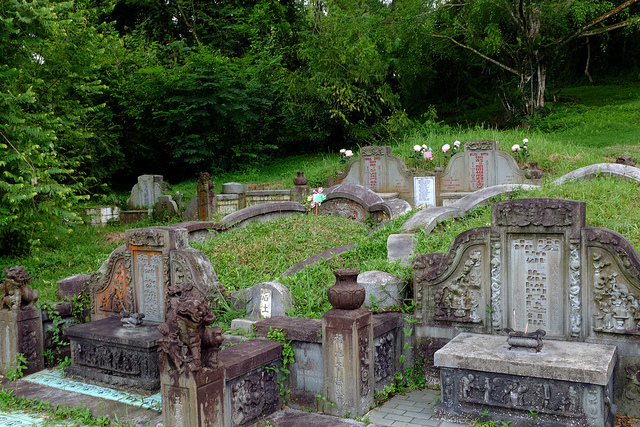
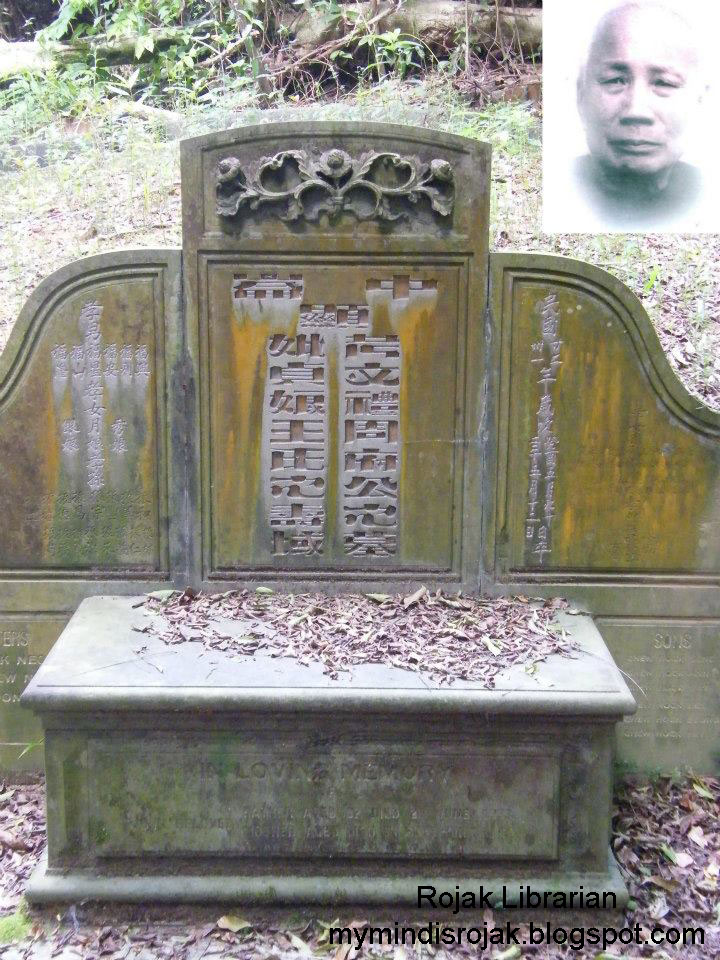


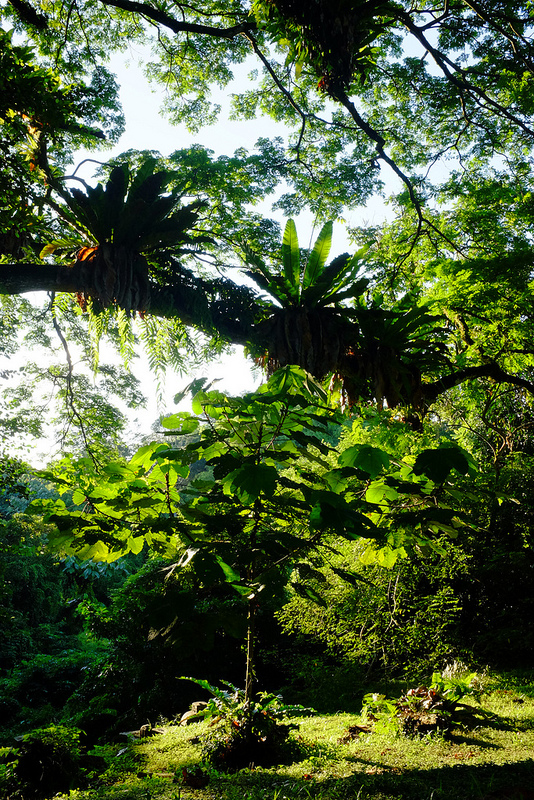
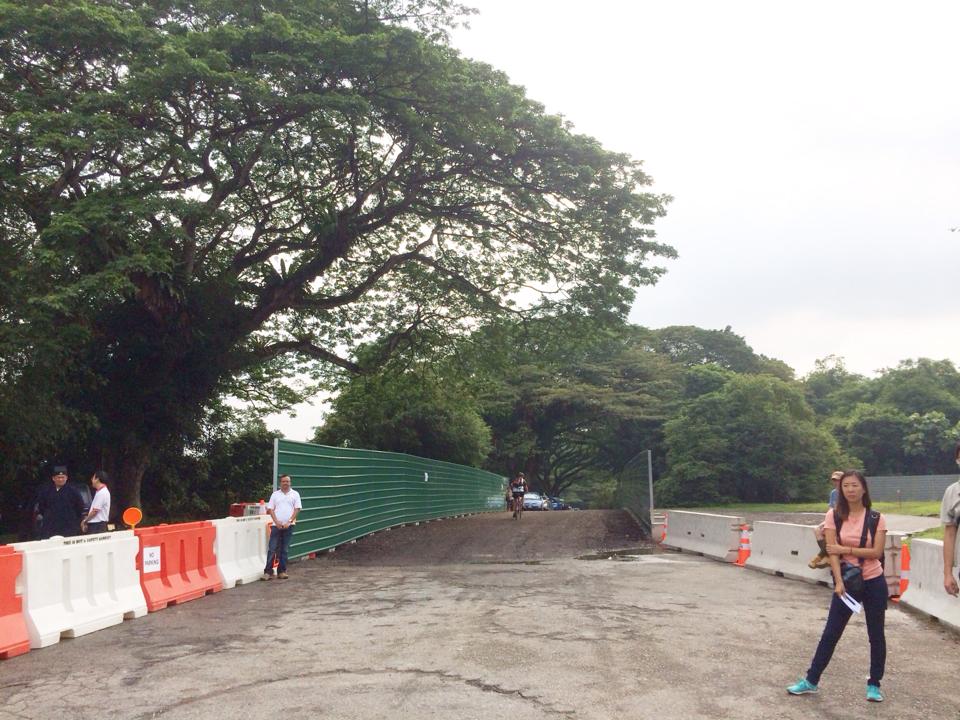

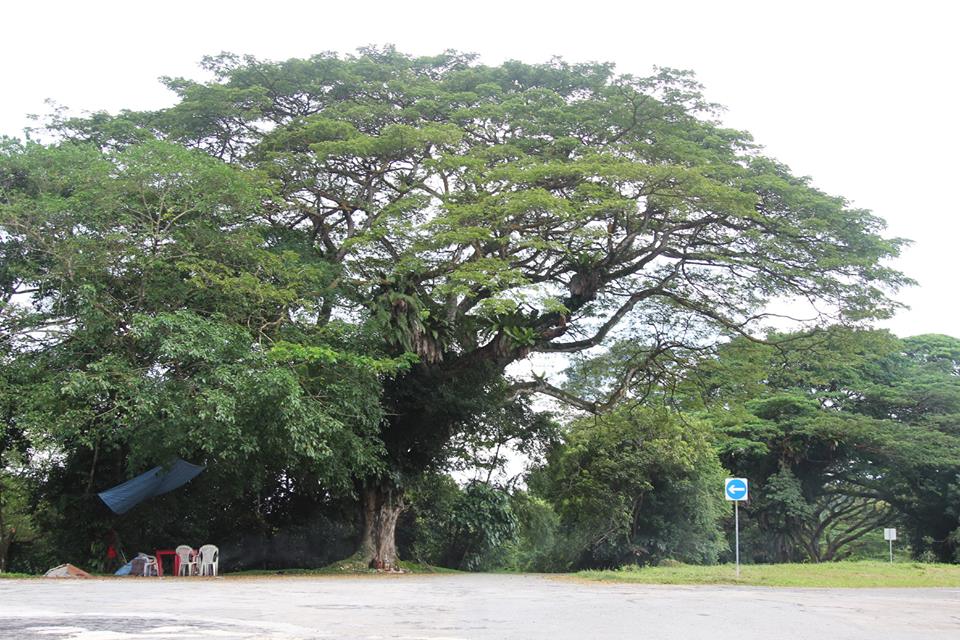

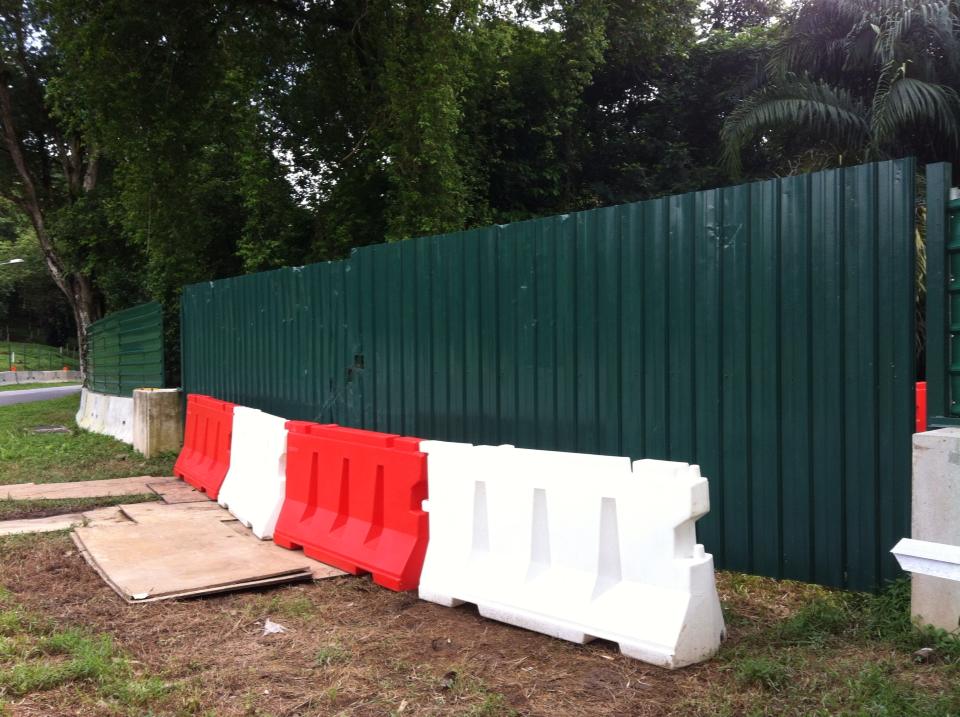
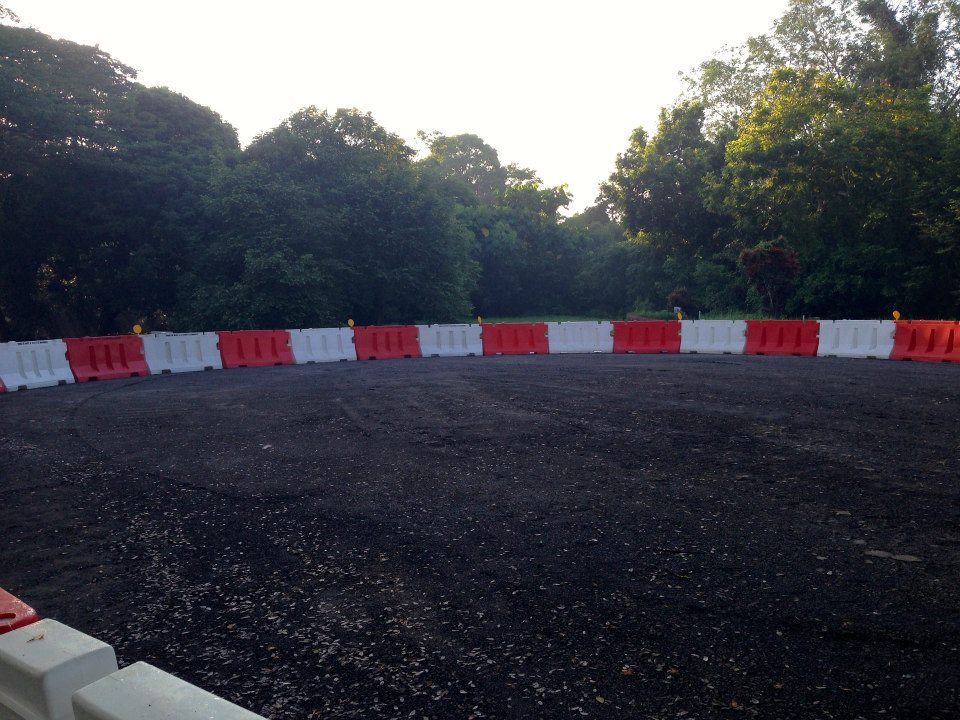
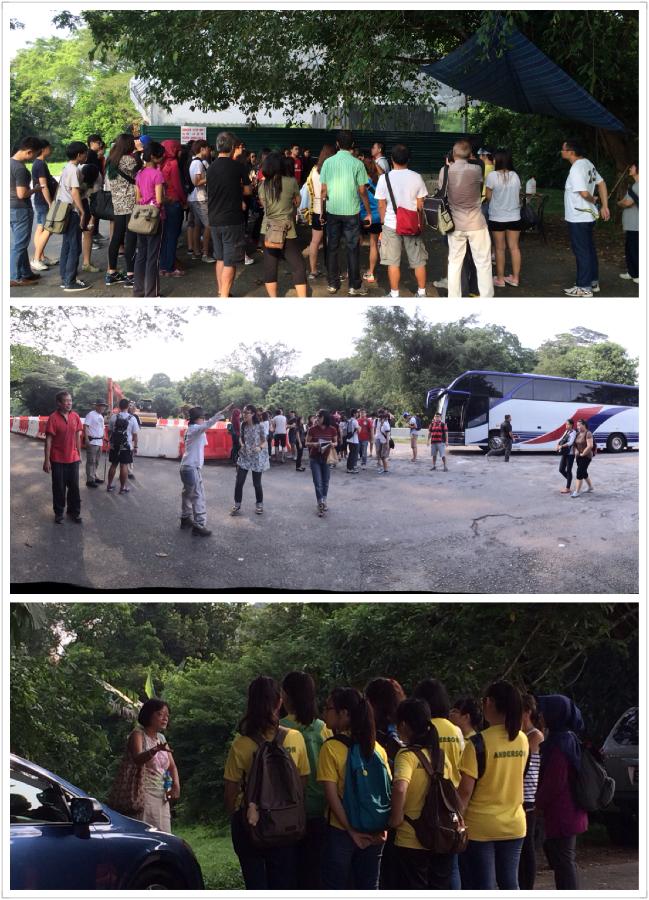
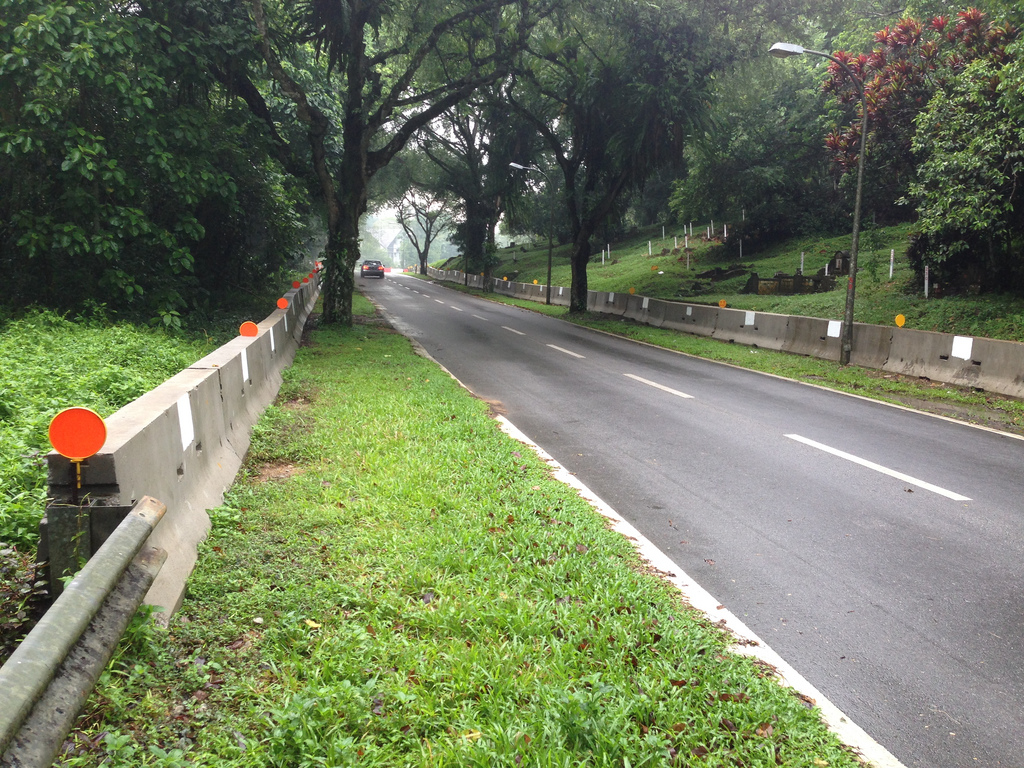
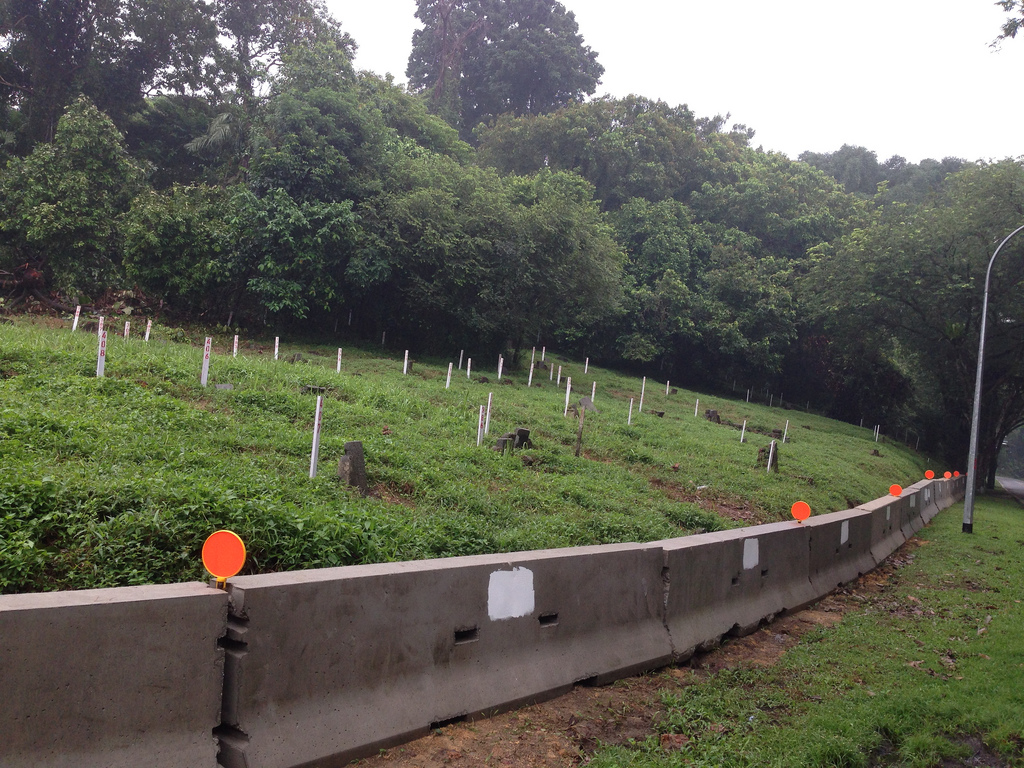
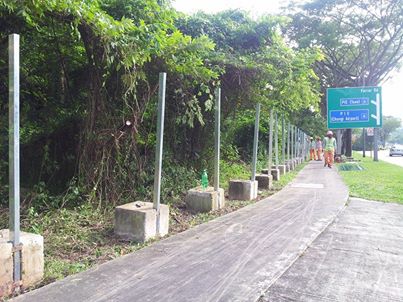


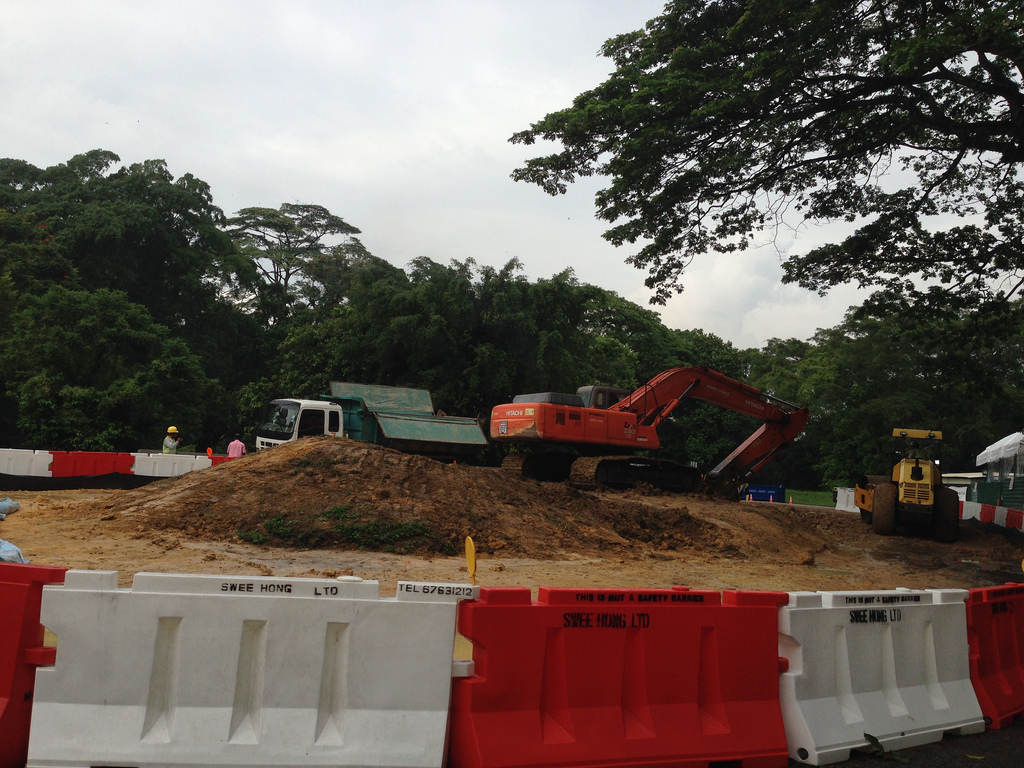
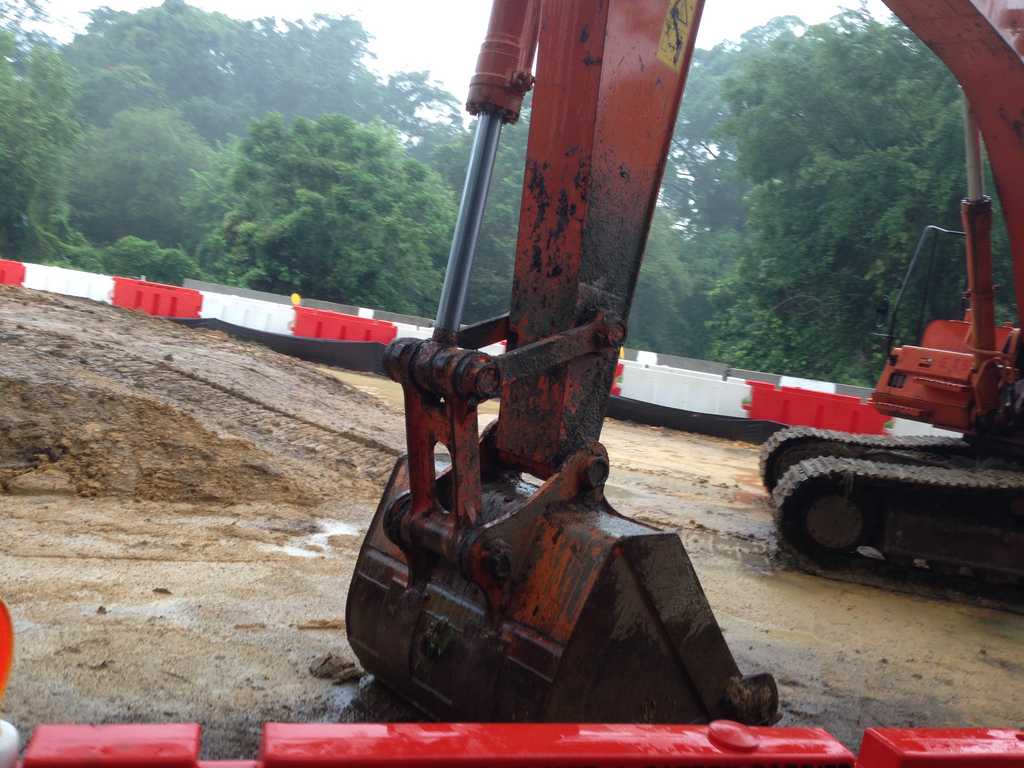
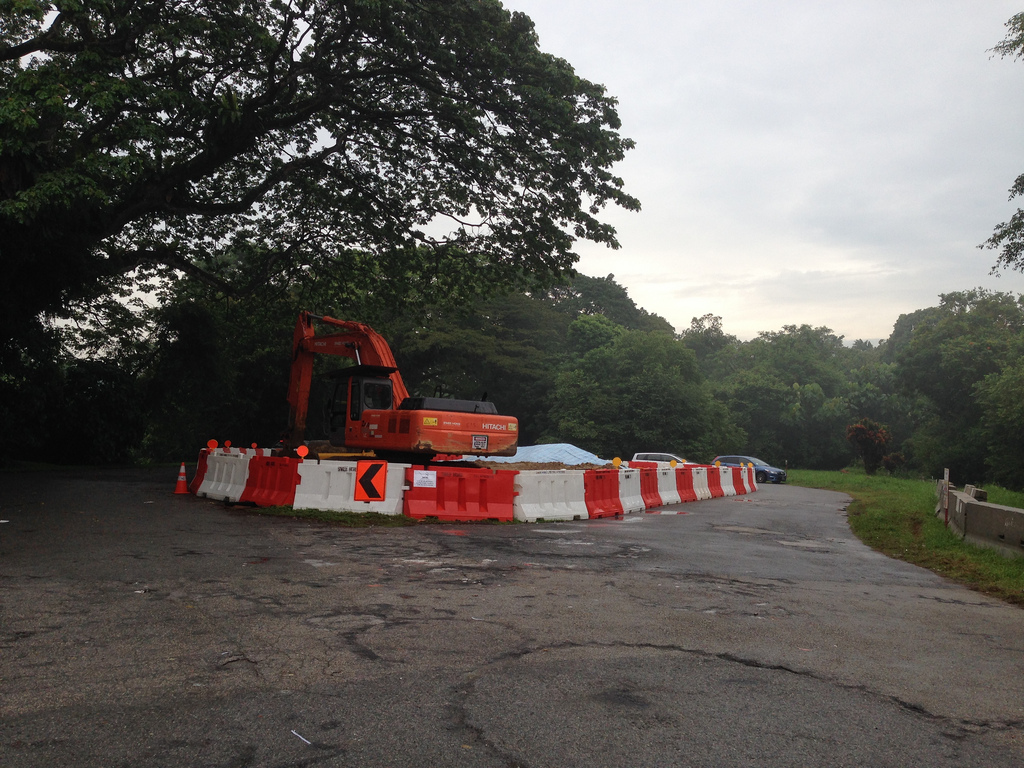
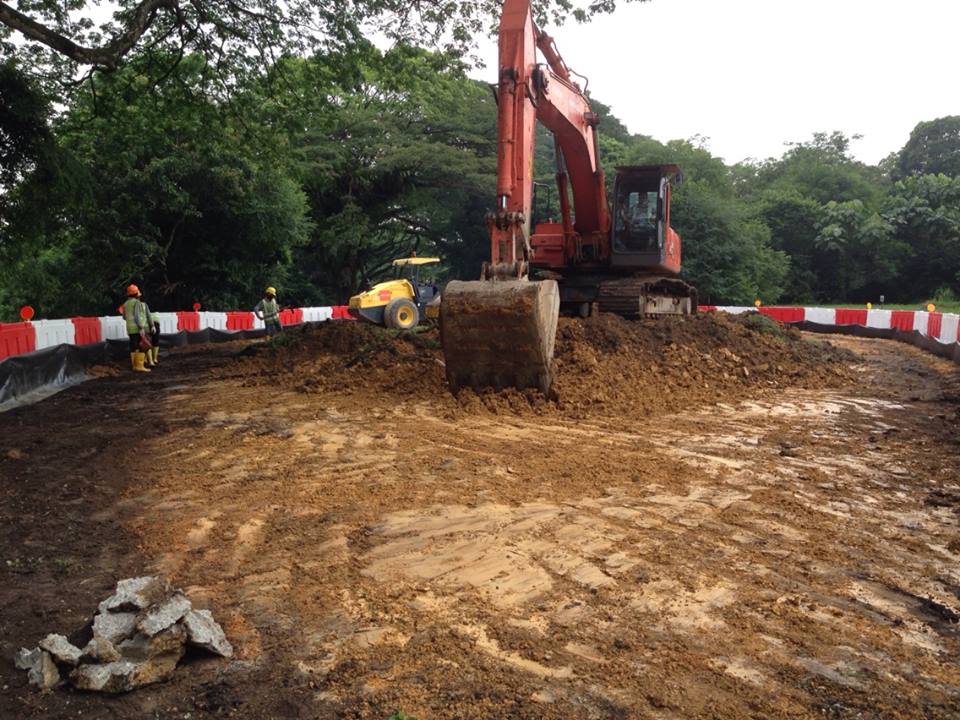
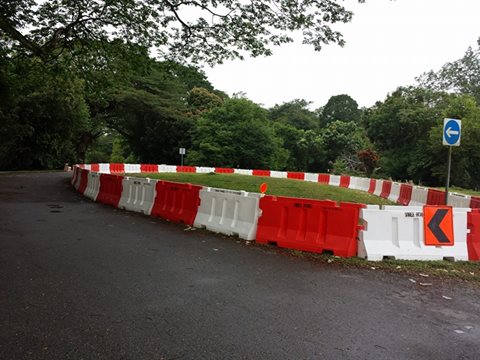

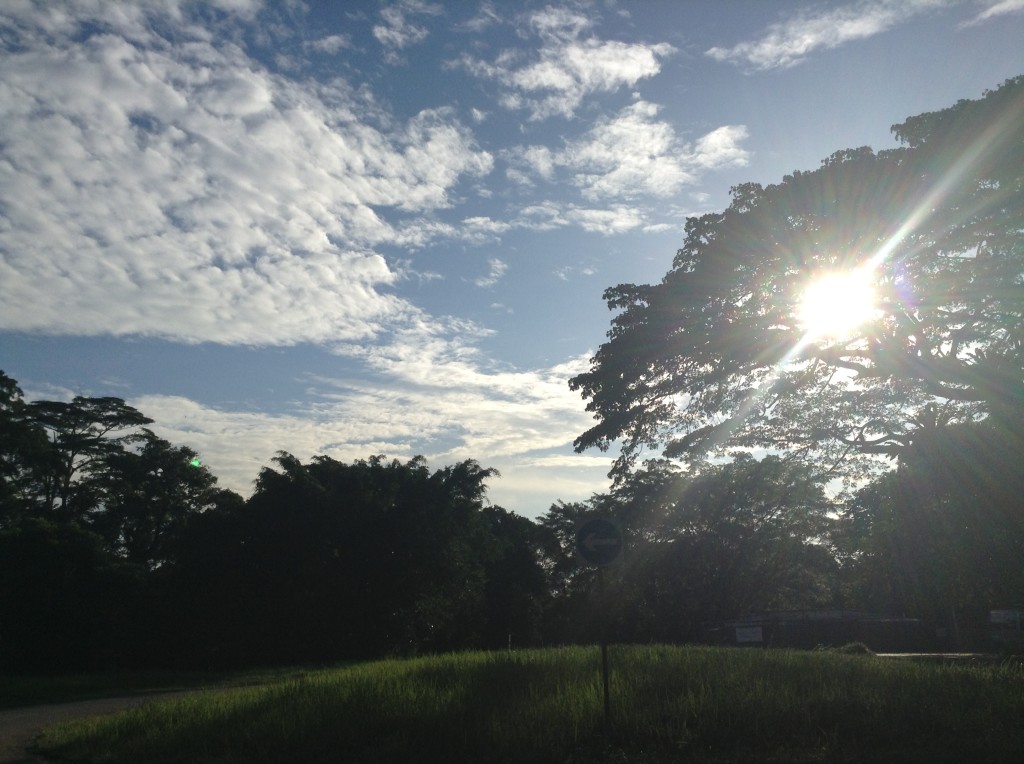
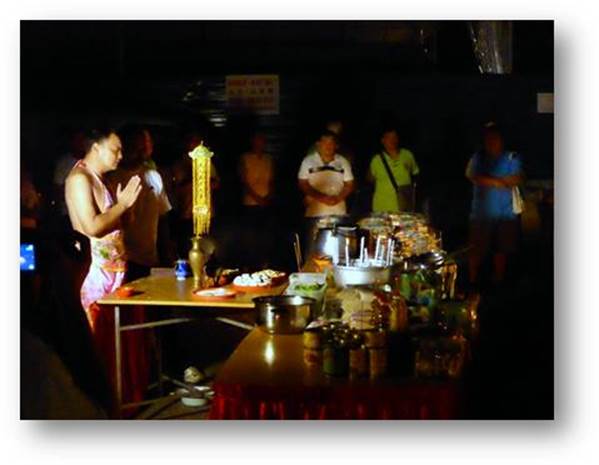
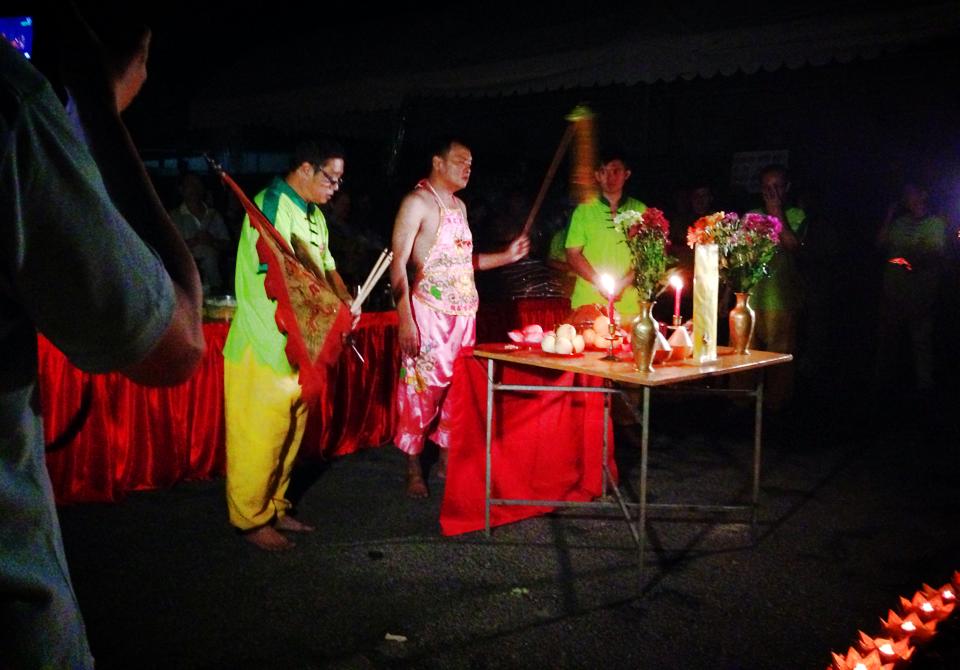
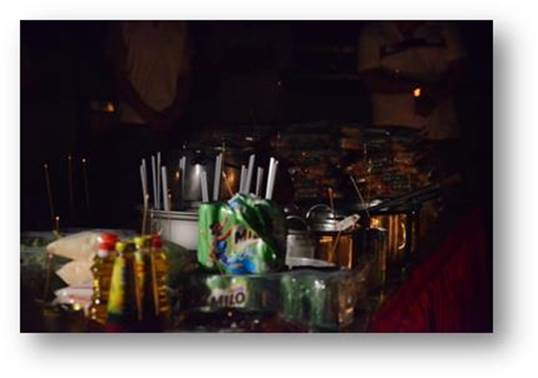

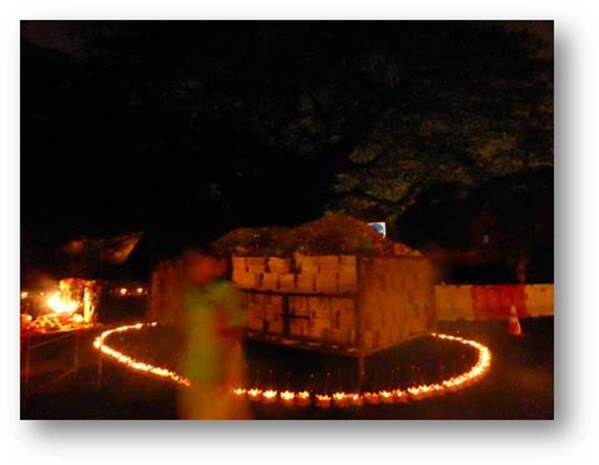
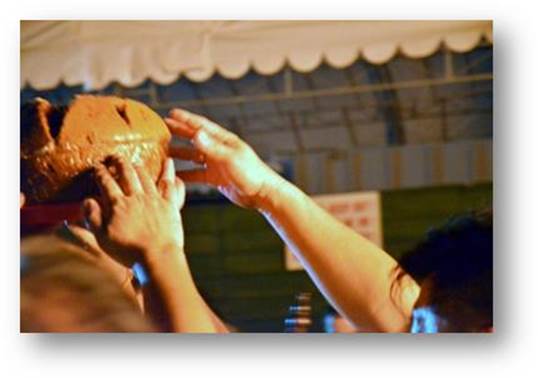
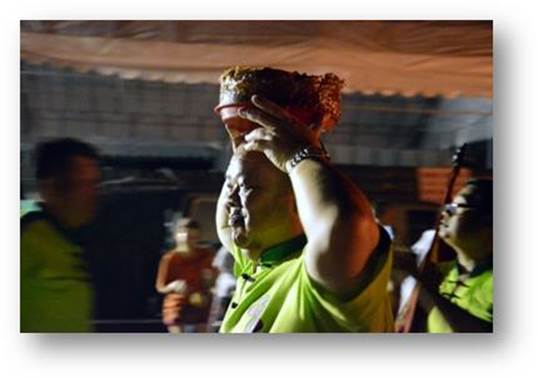
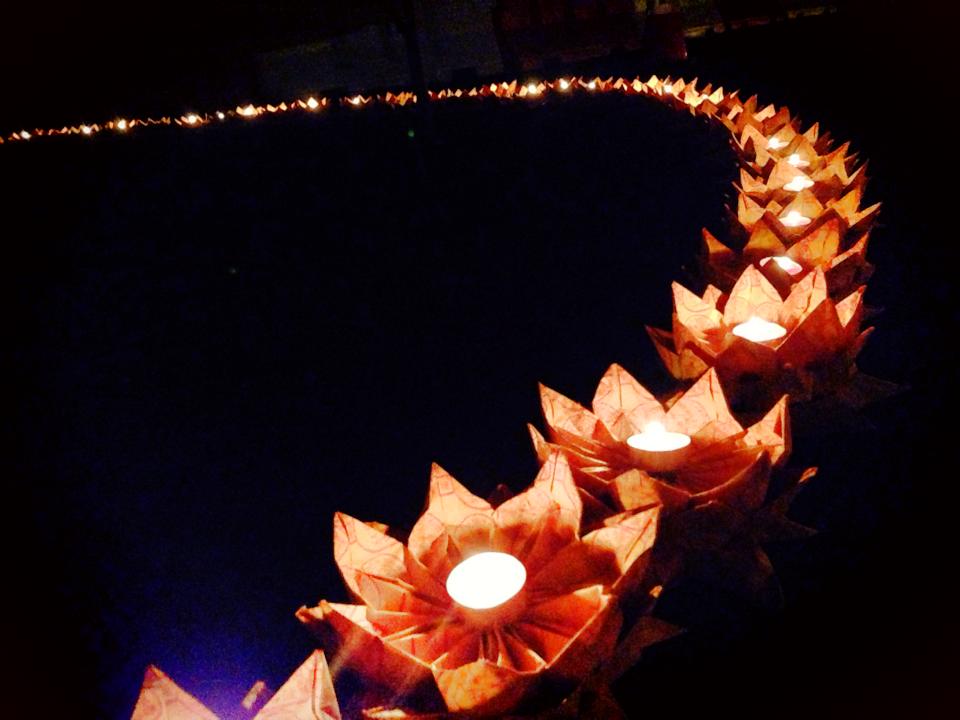

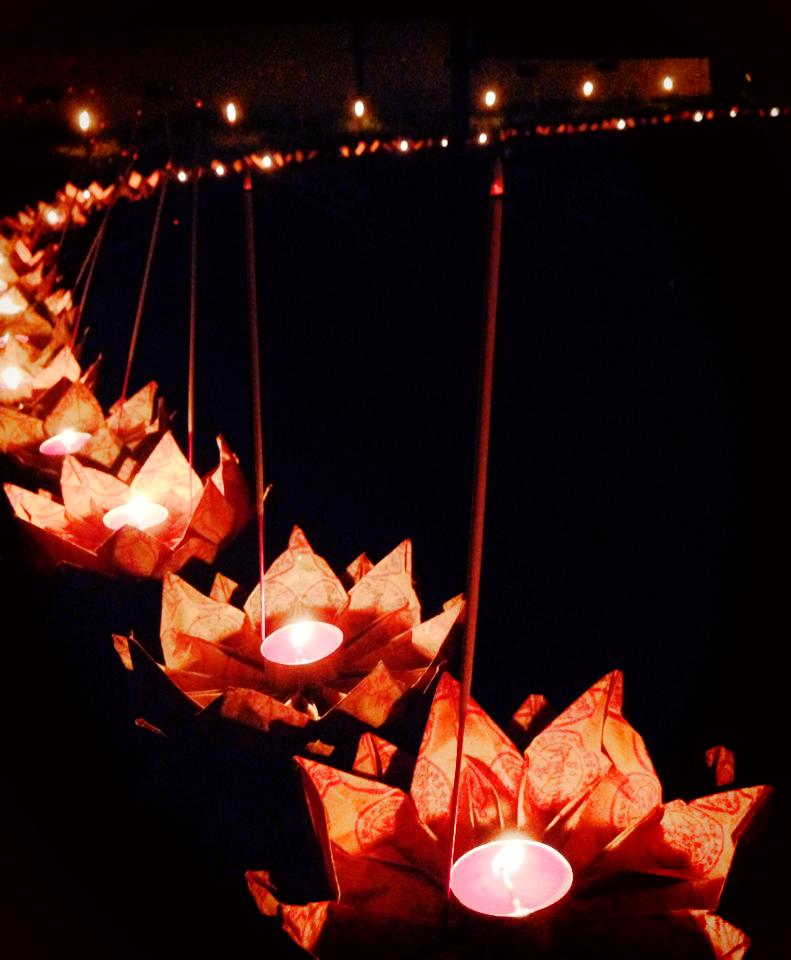
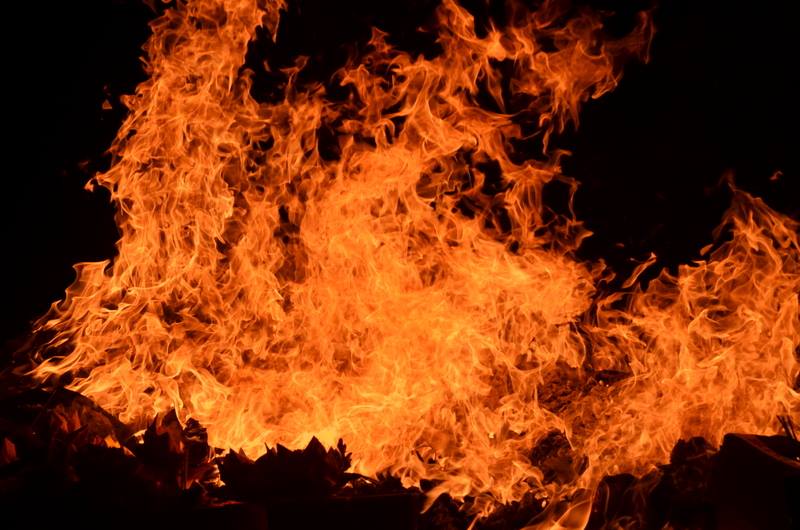
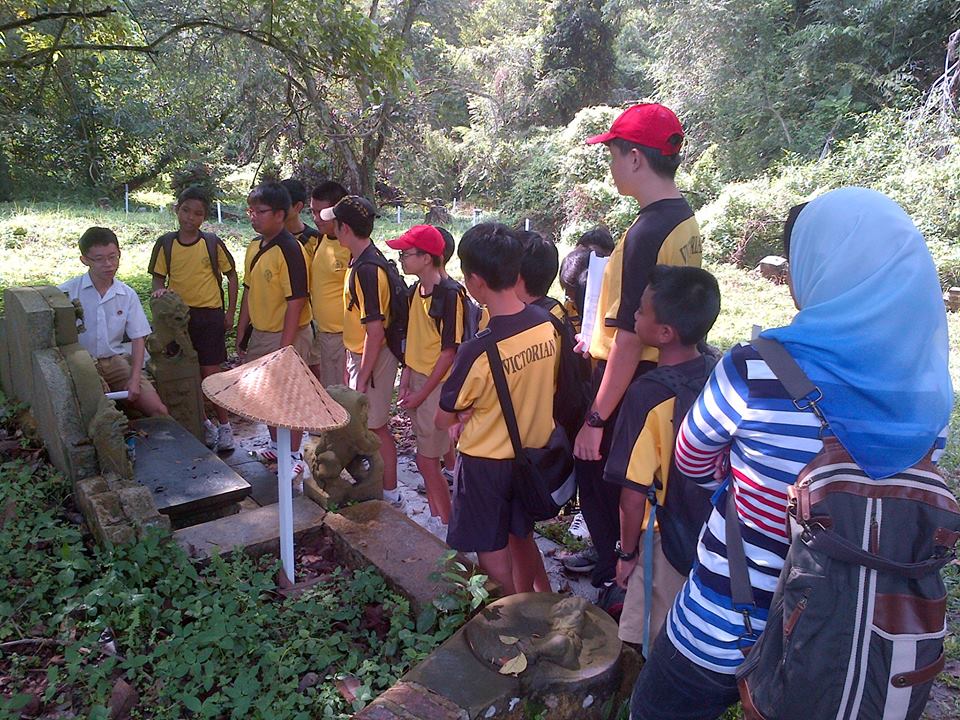
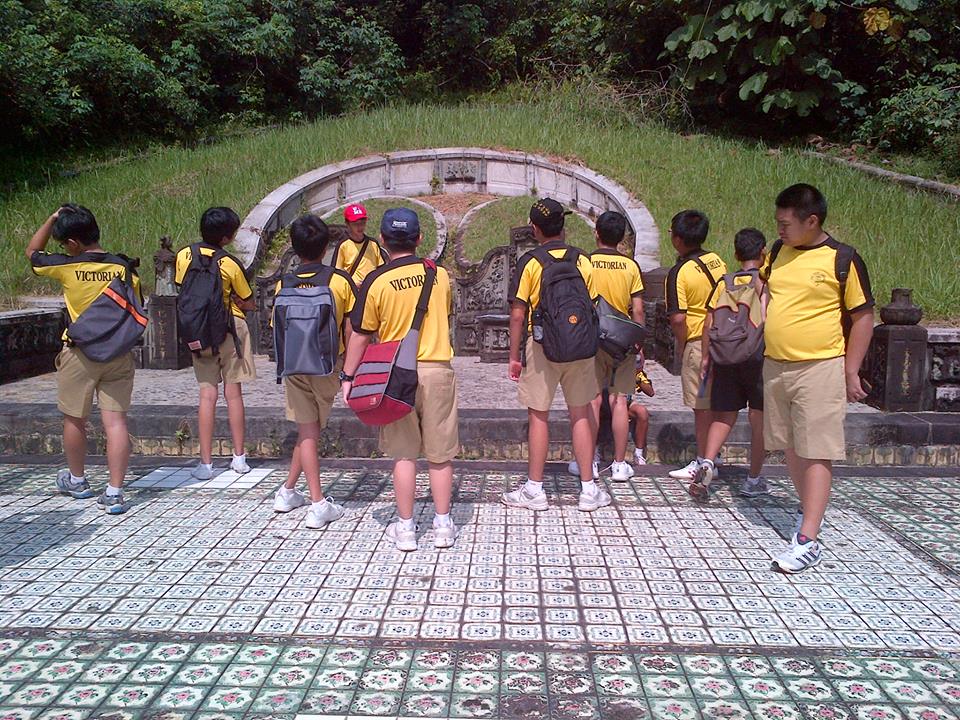

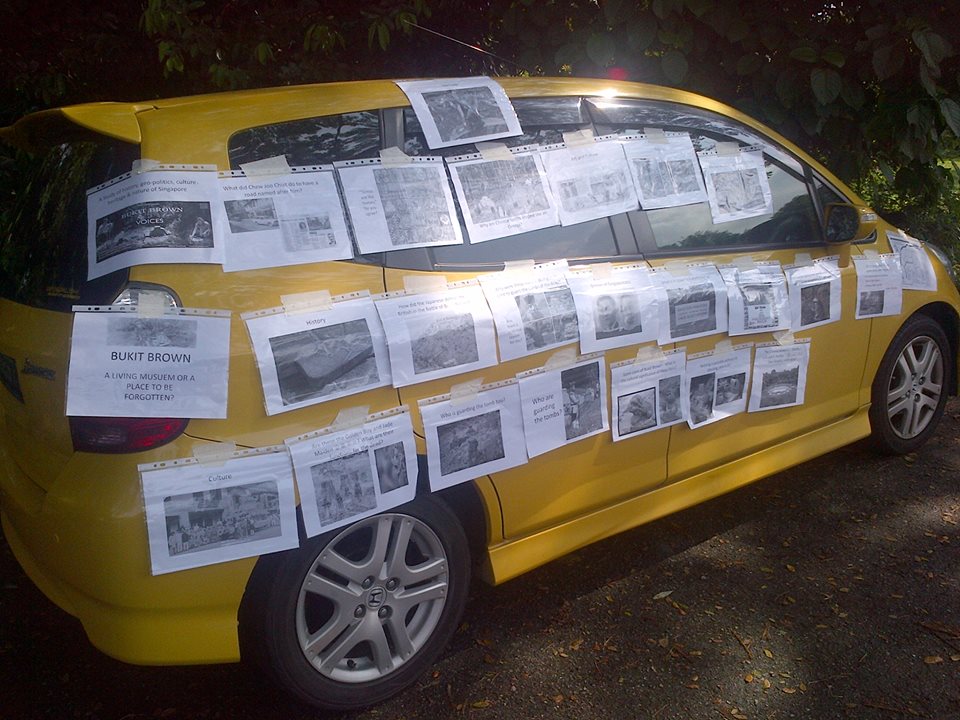

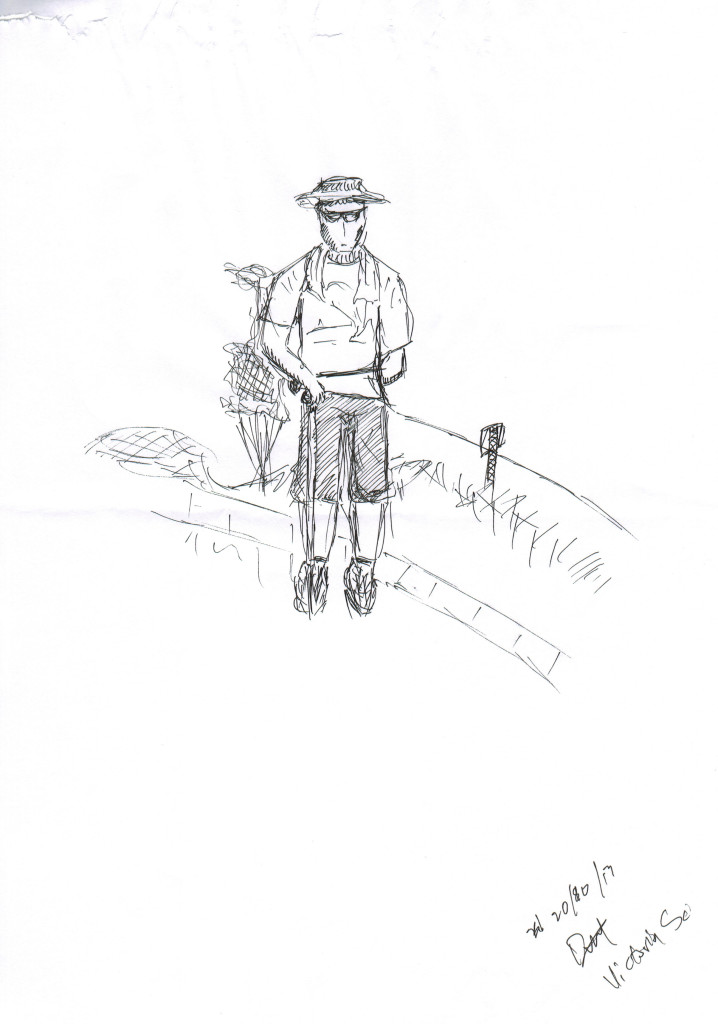
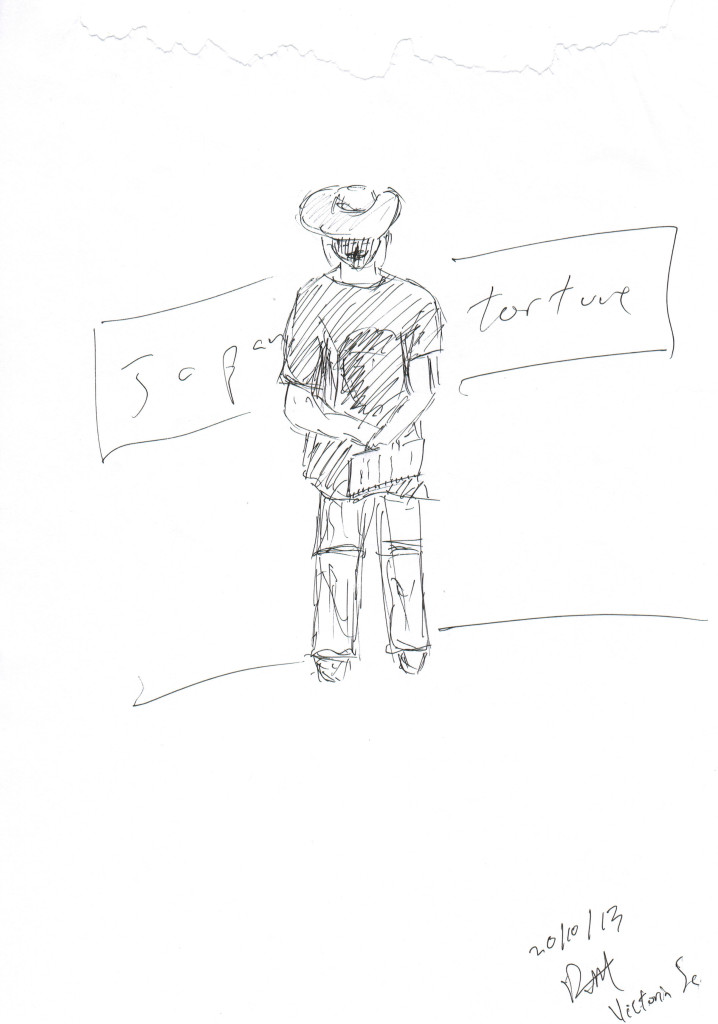









Recent Comments